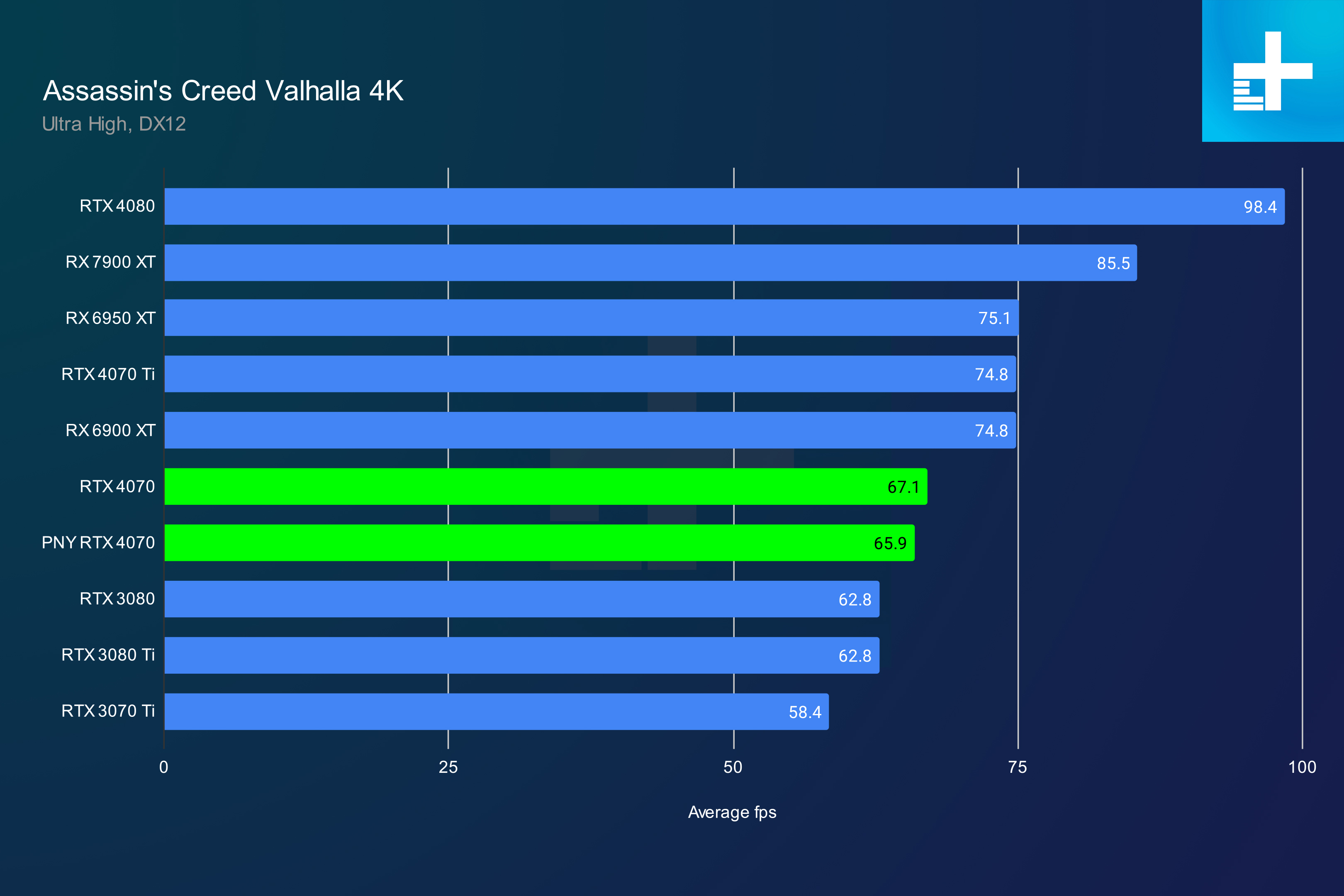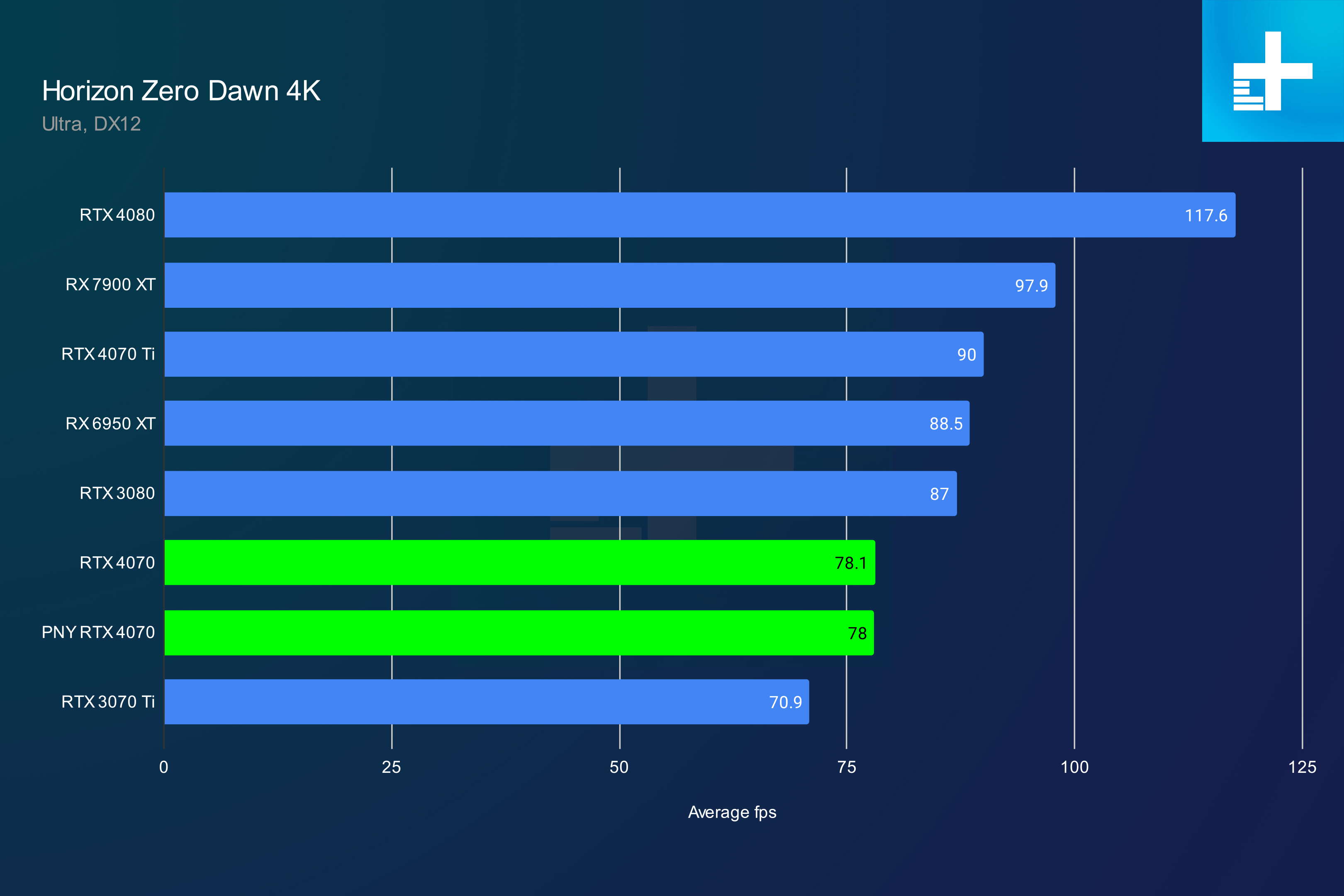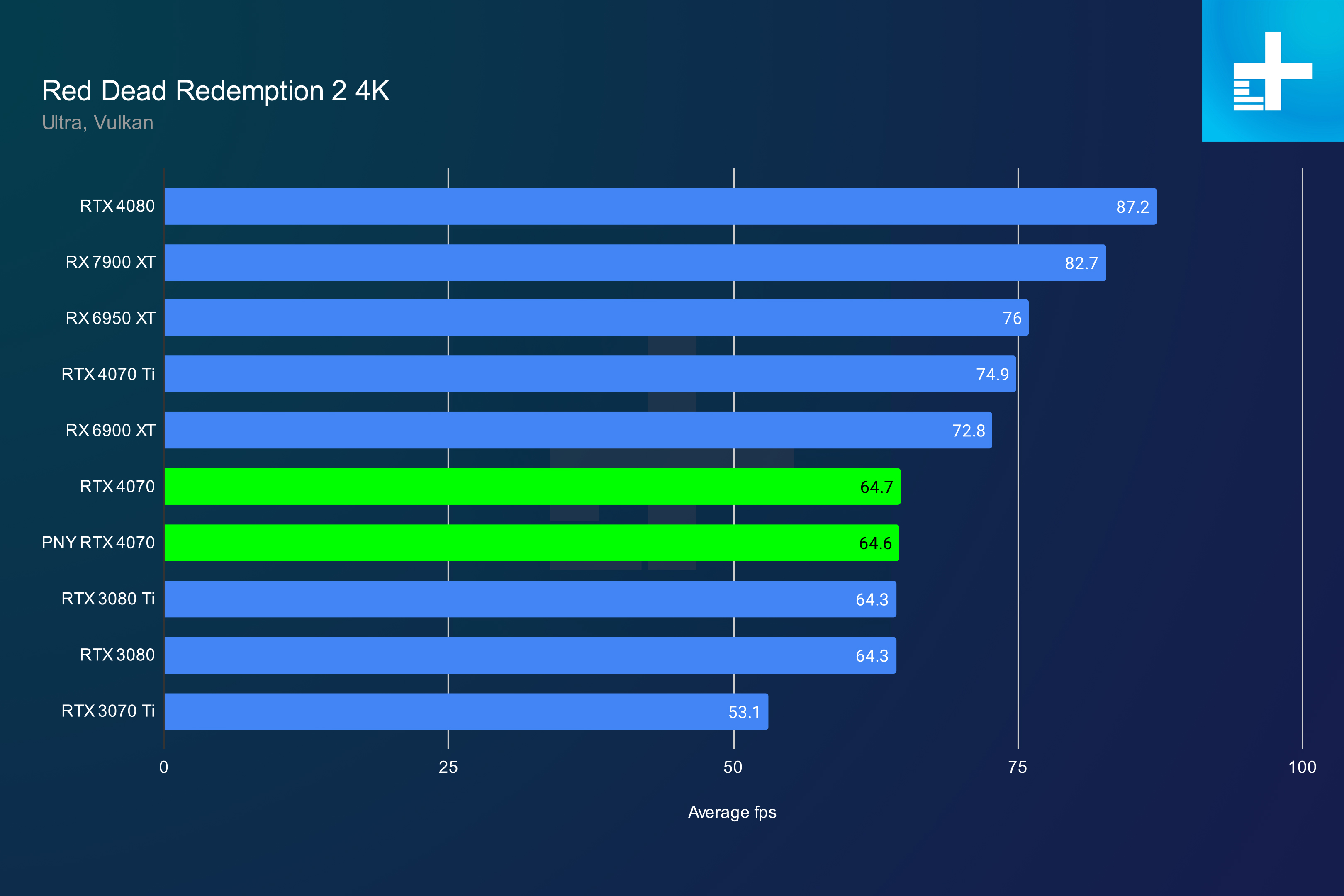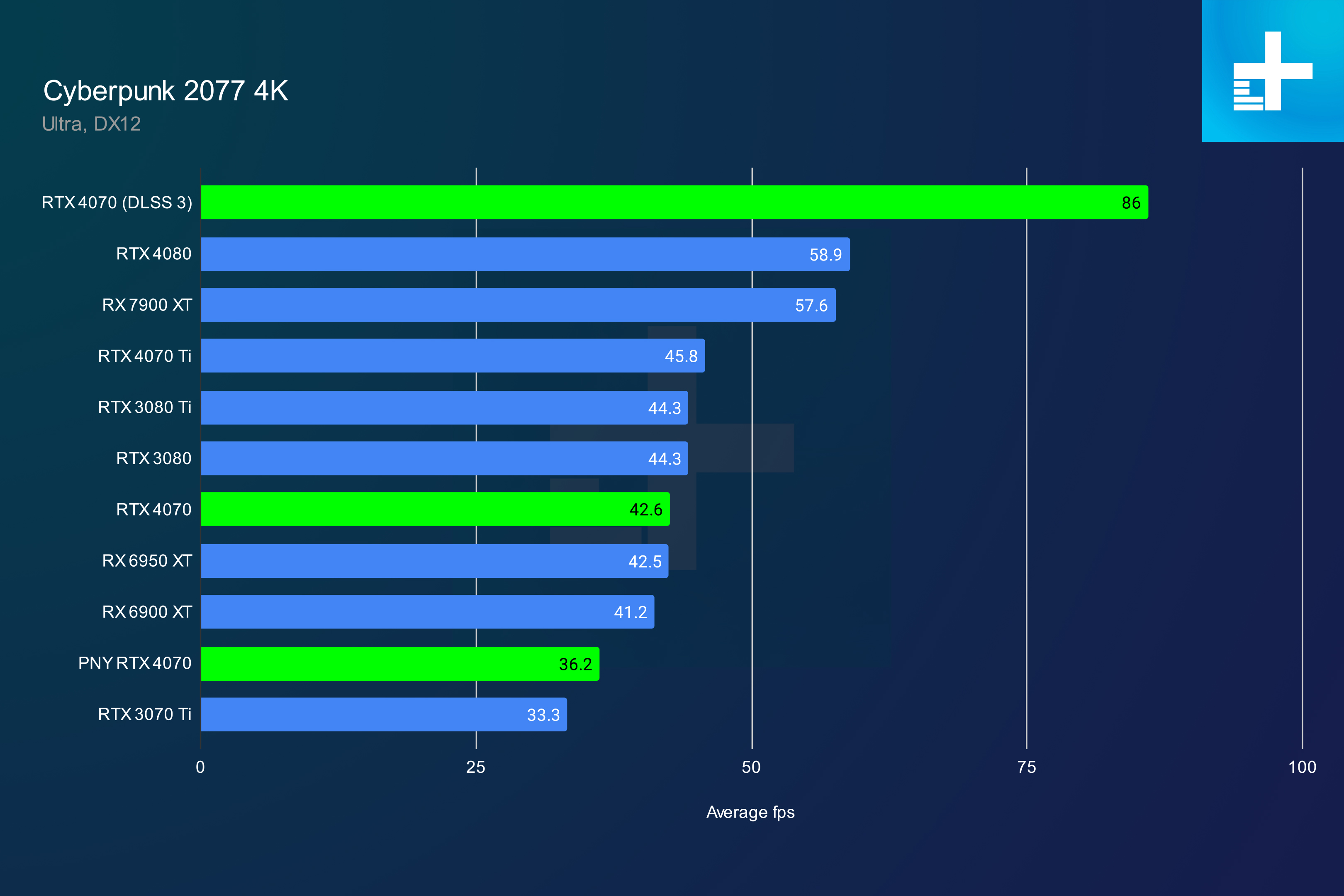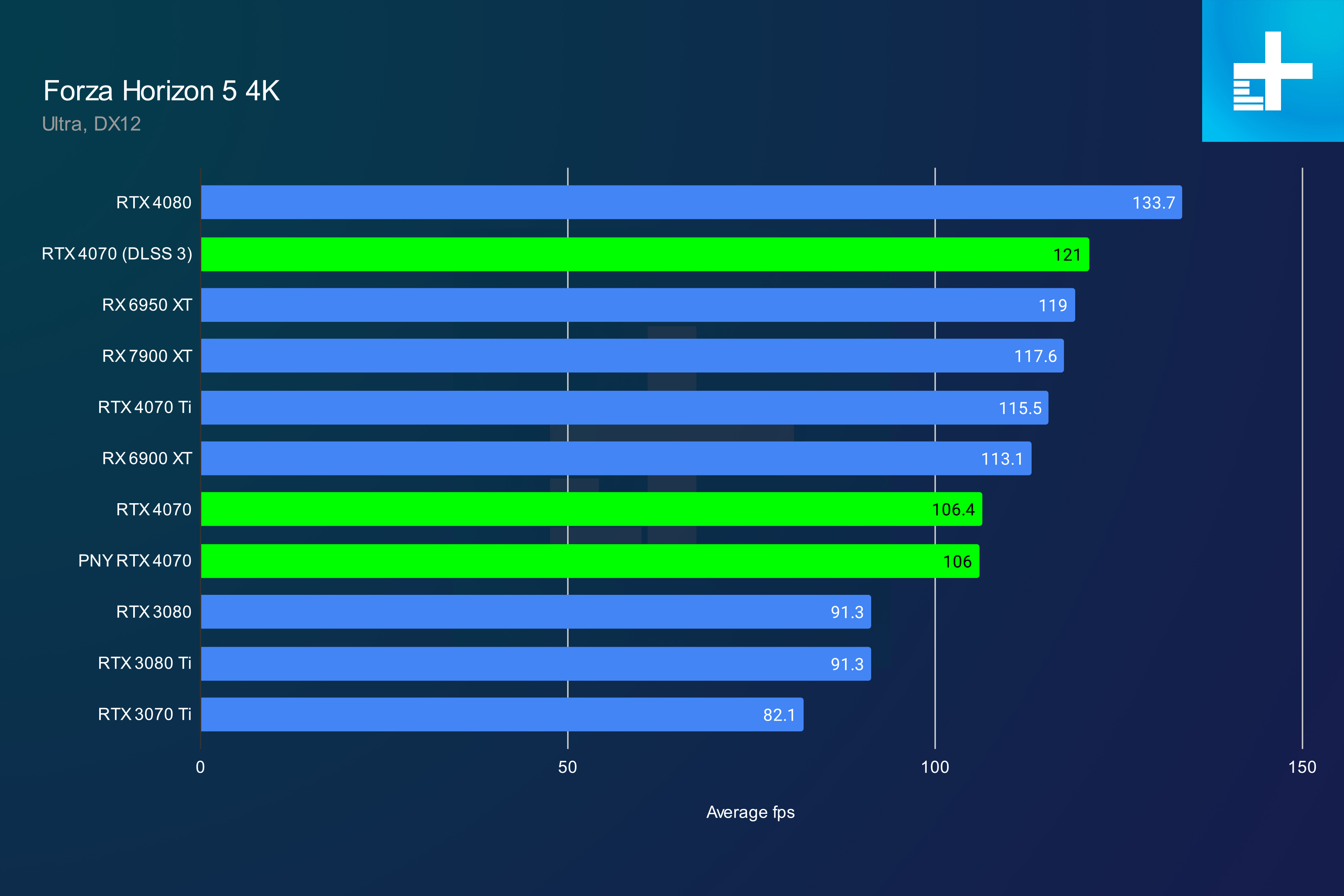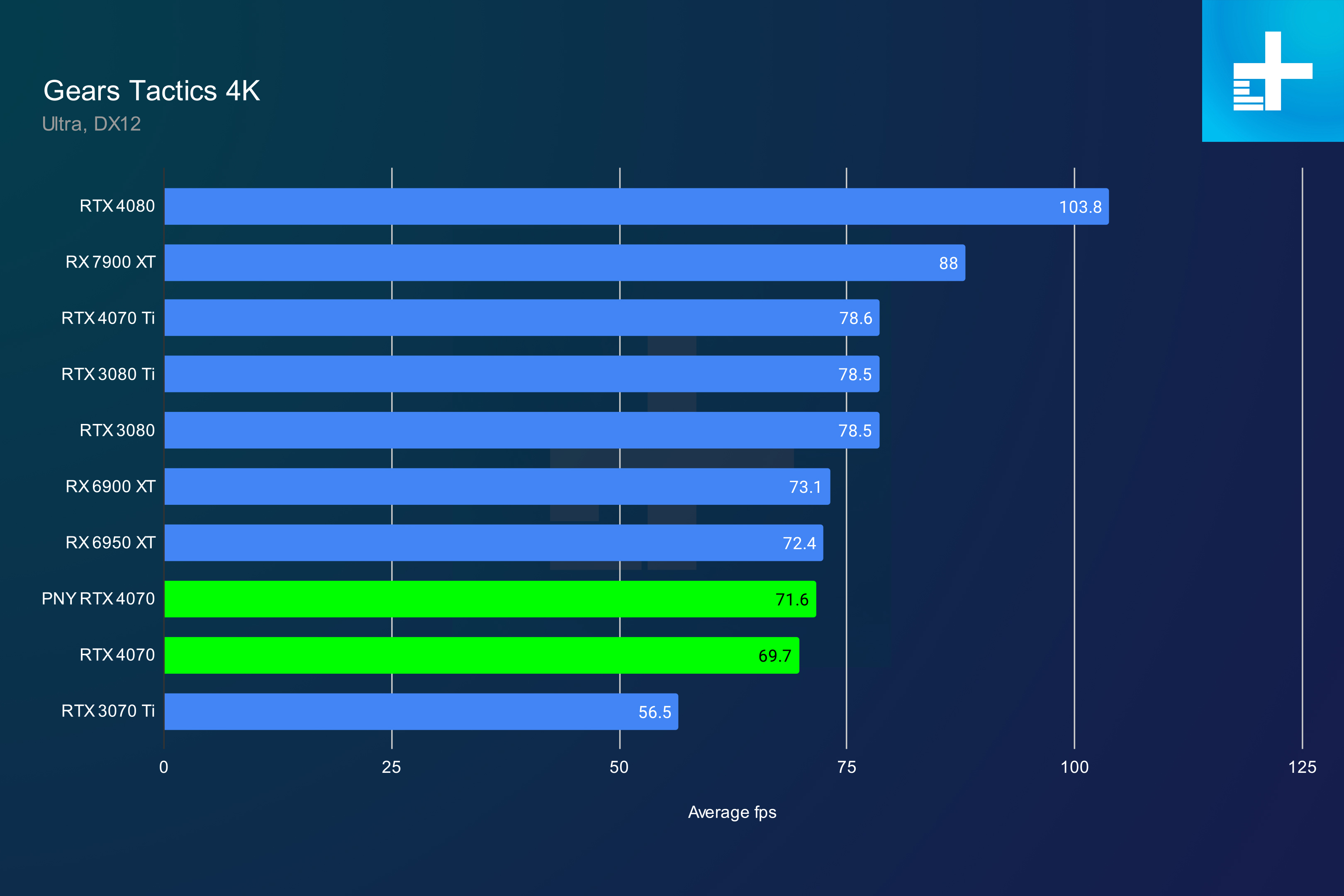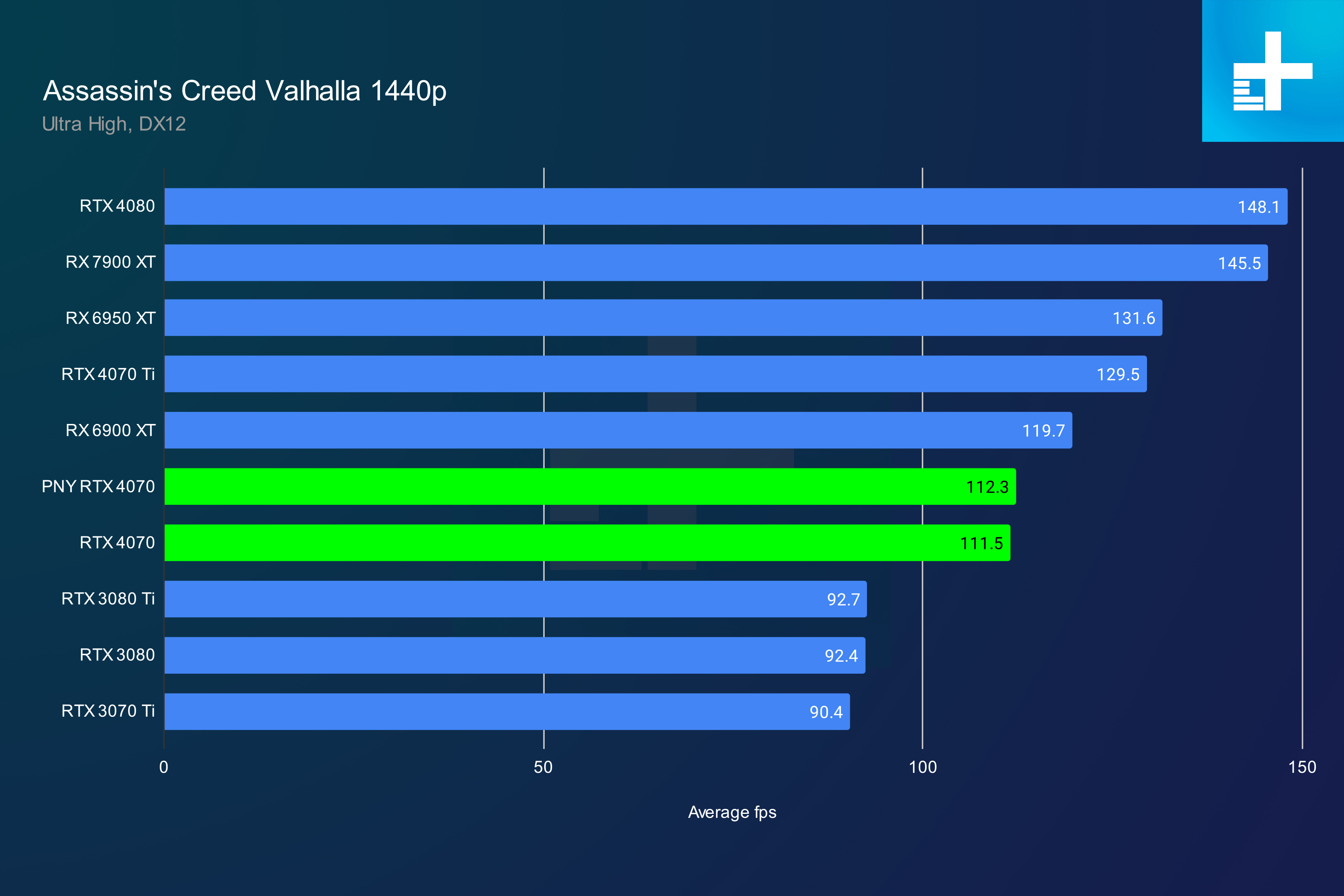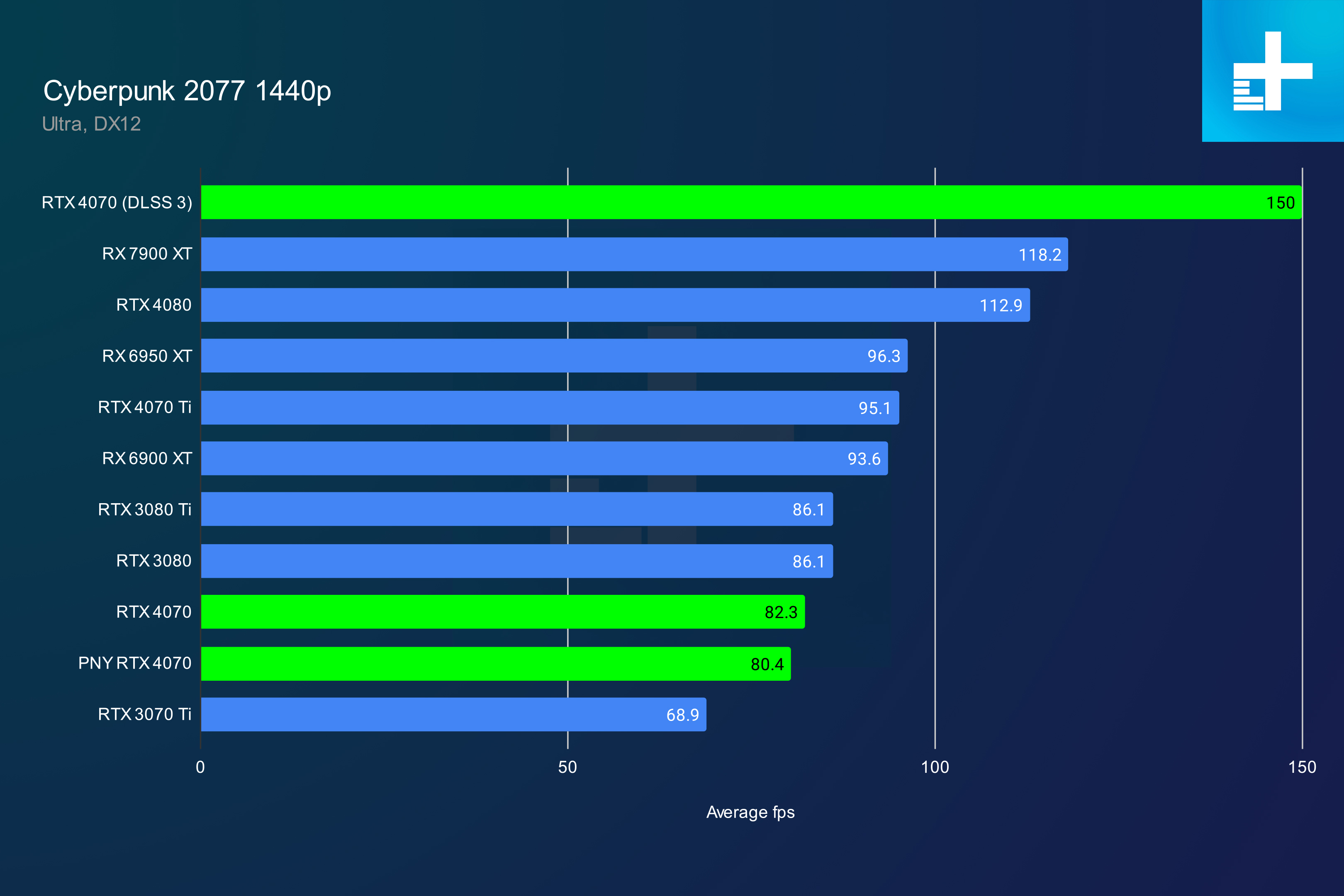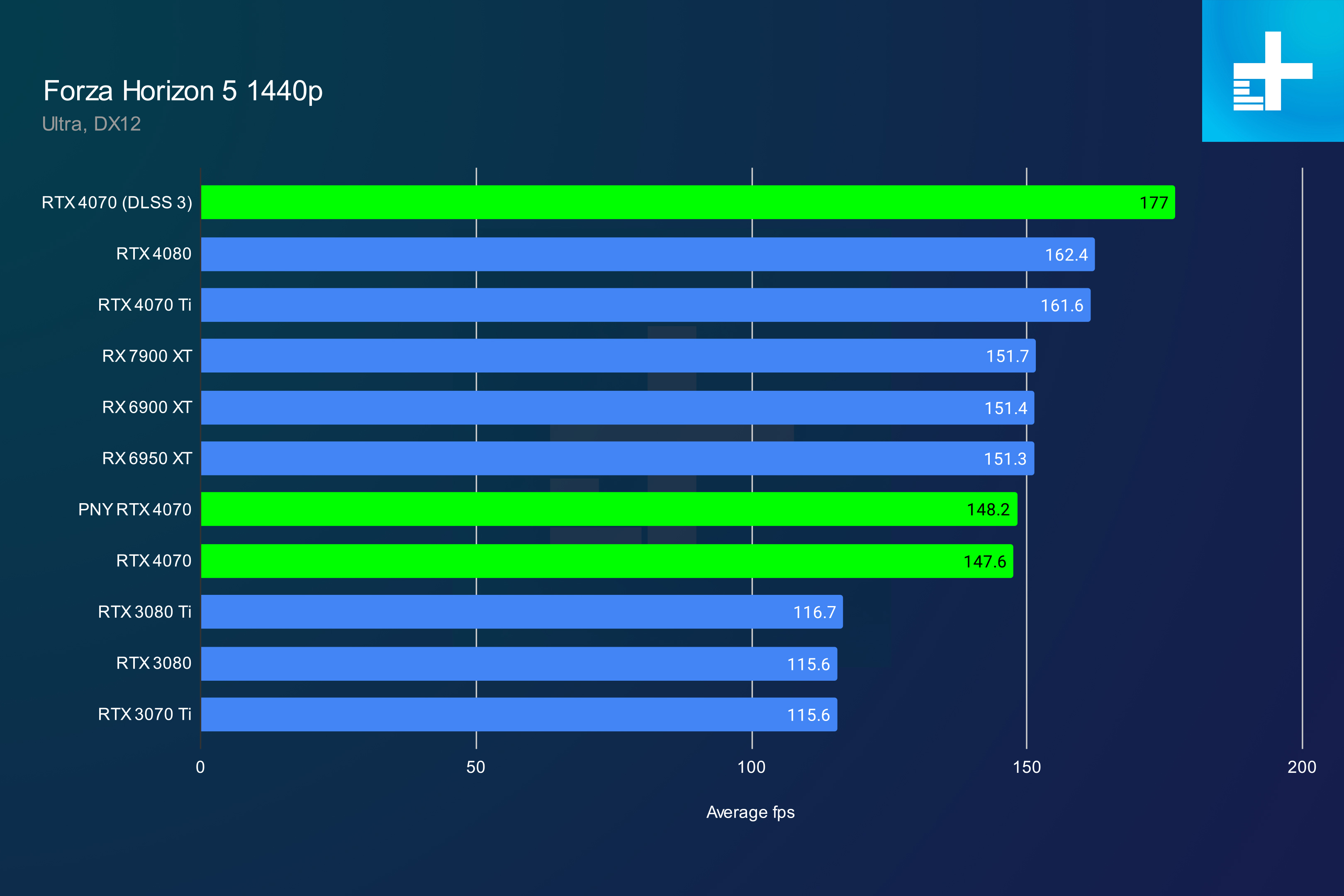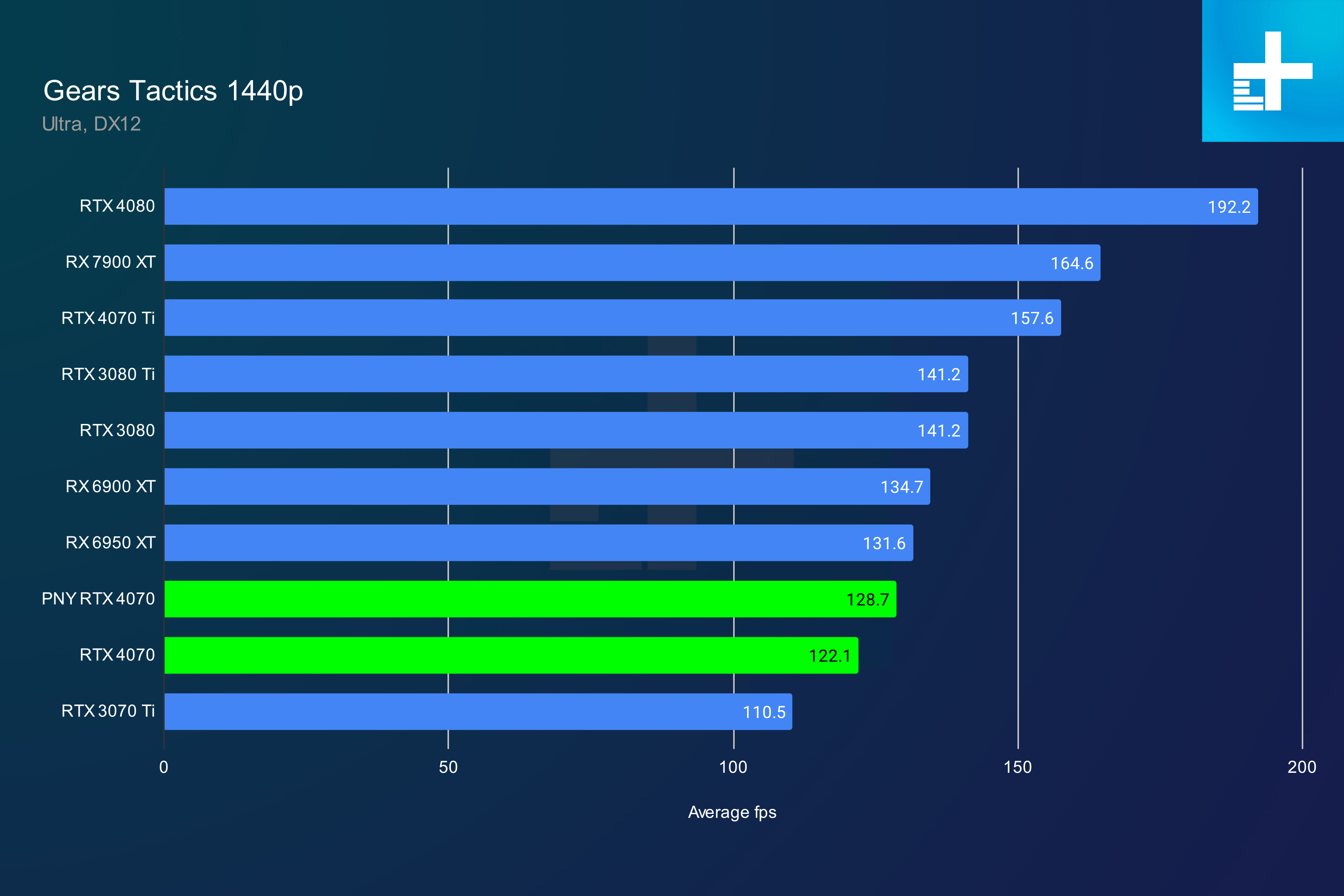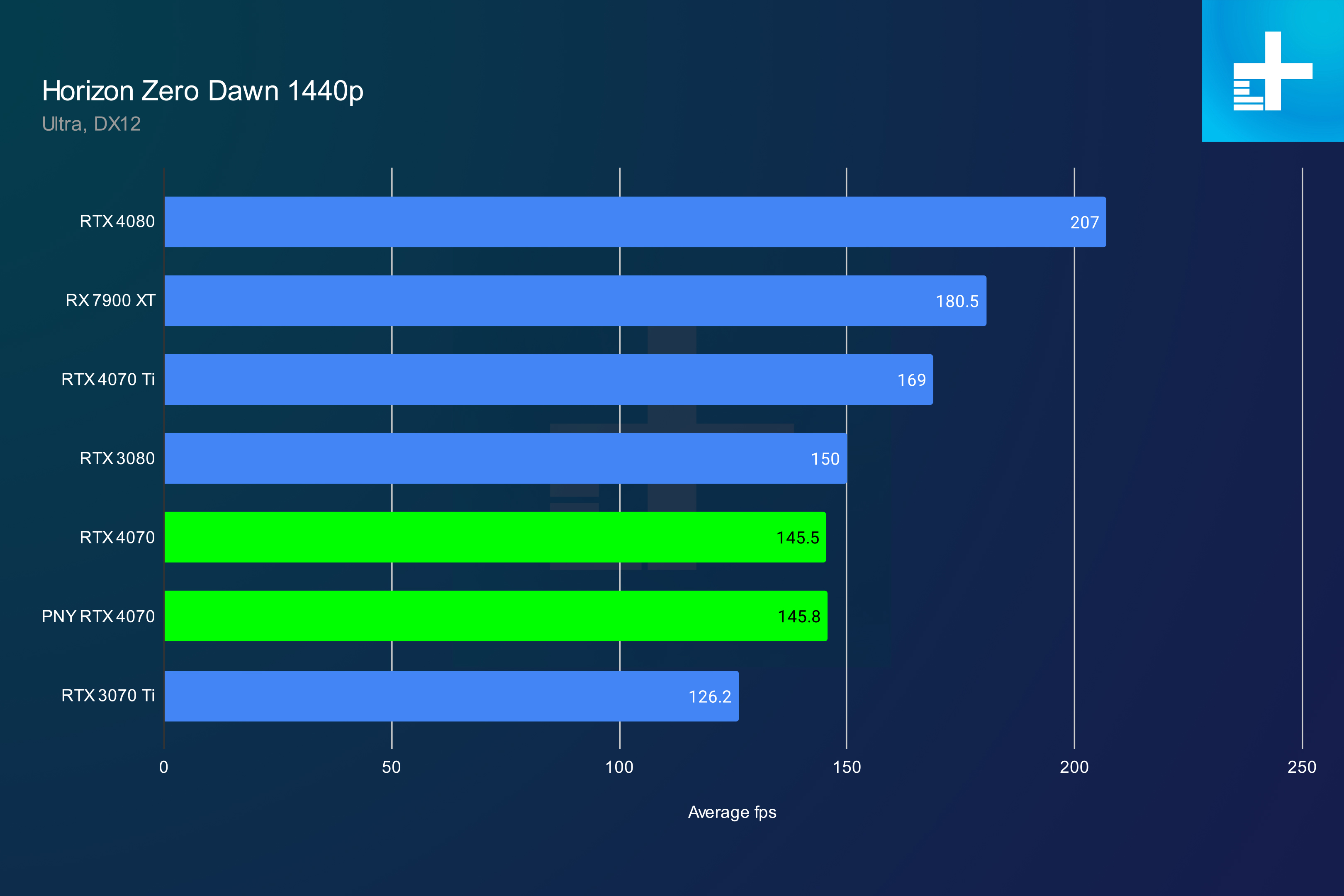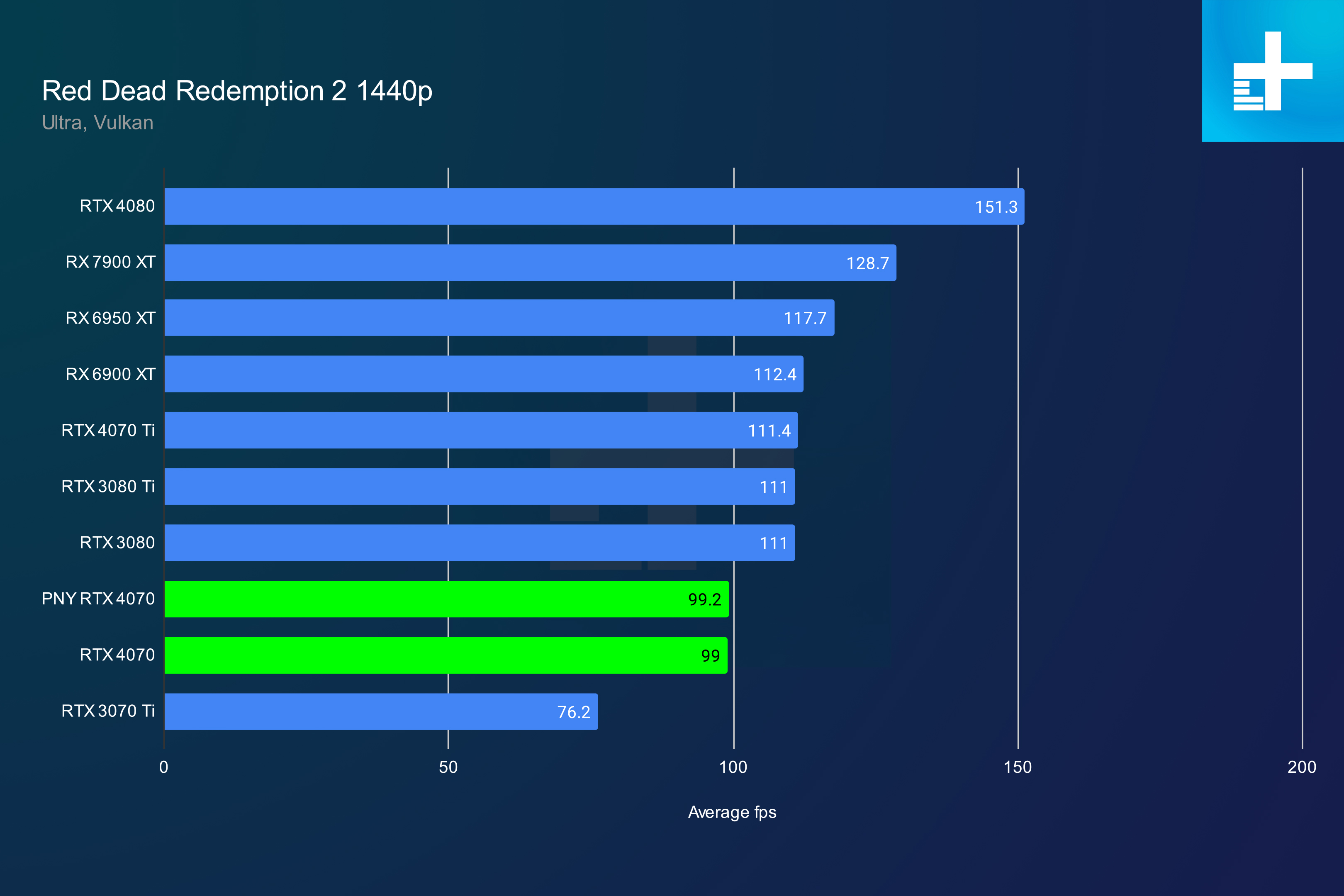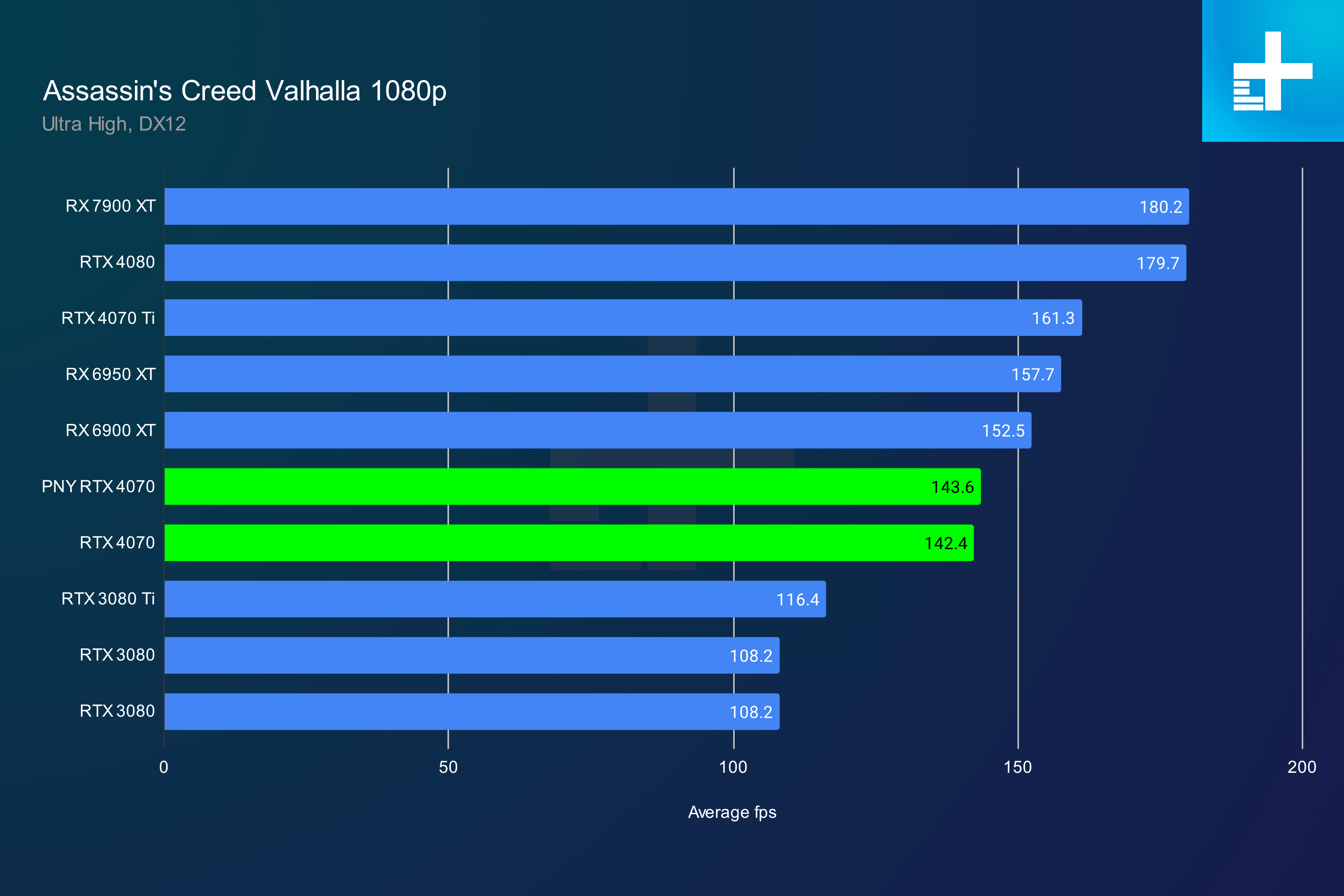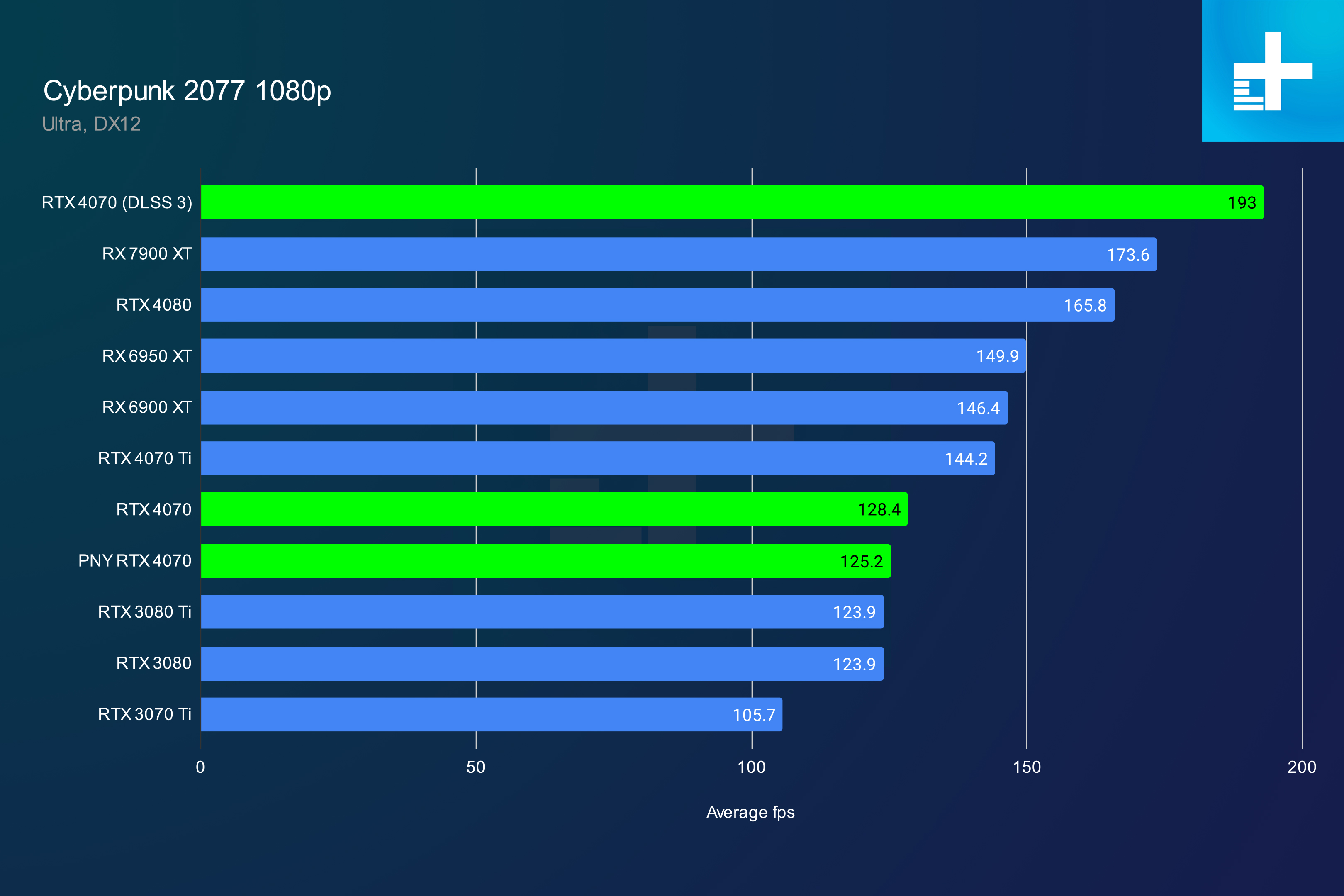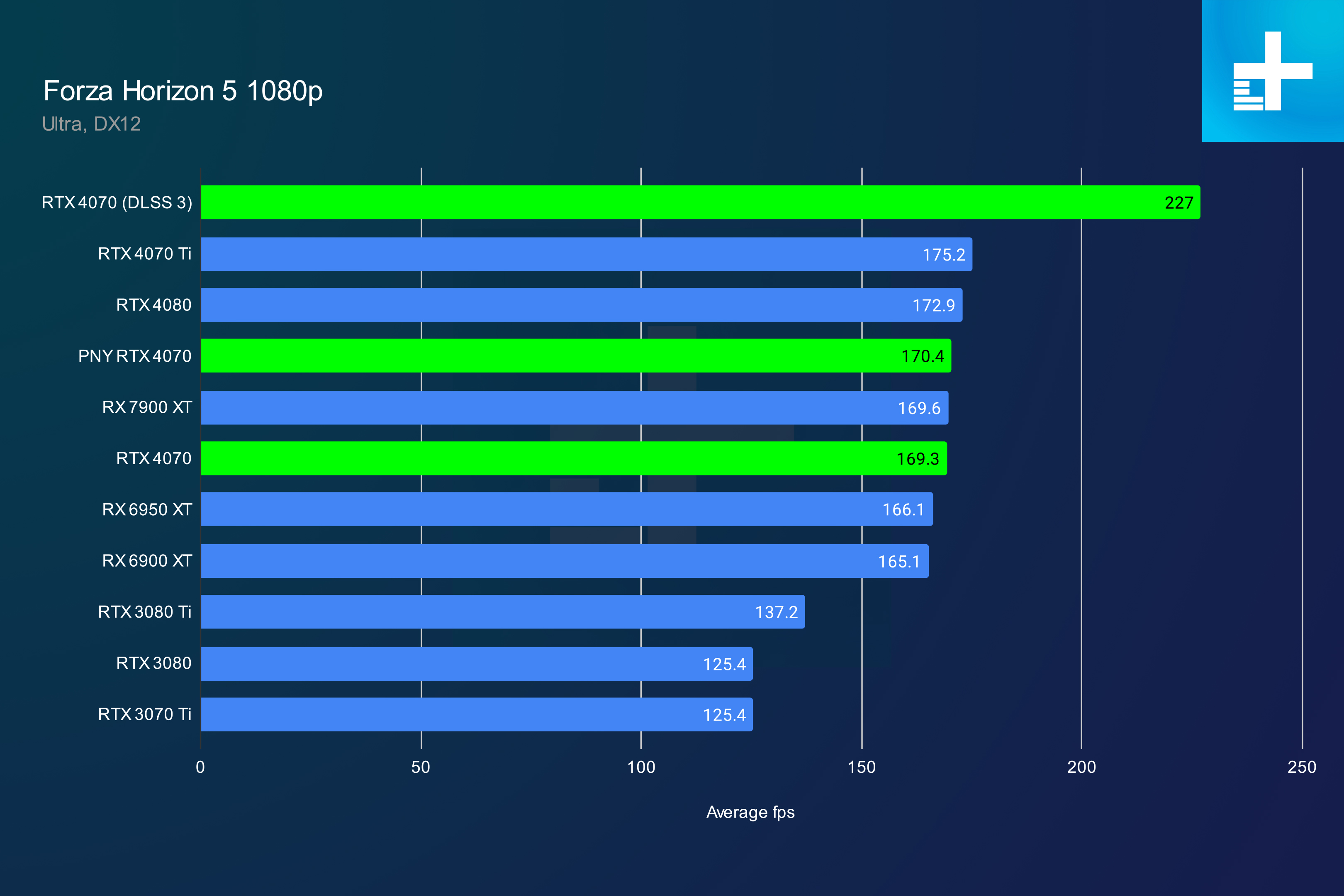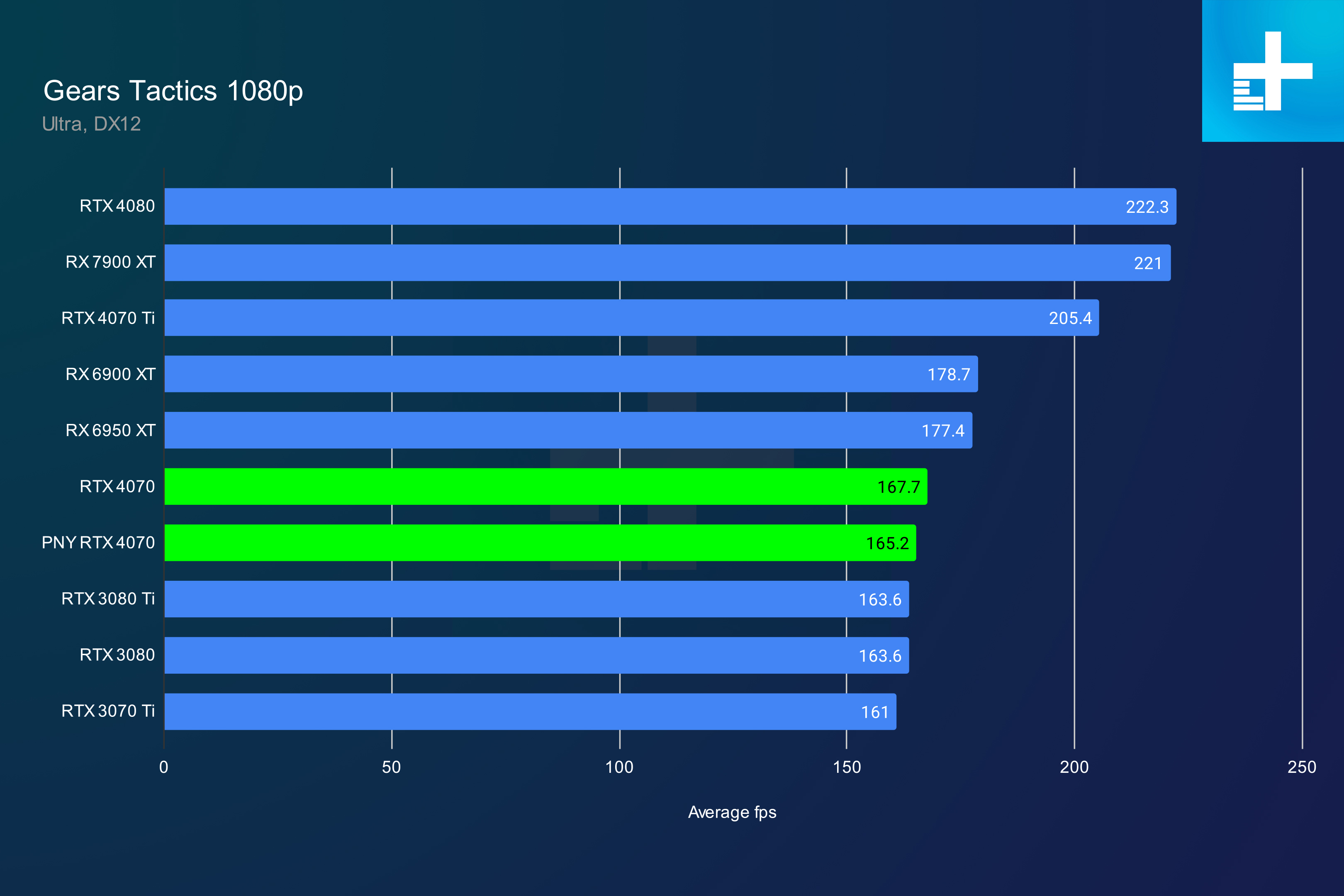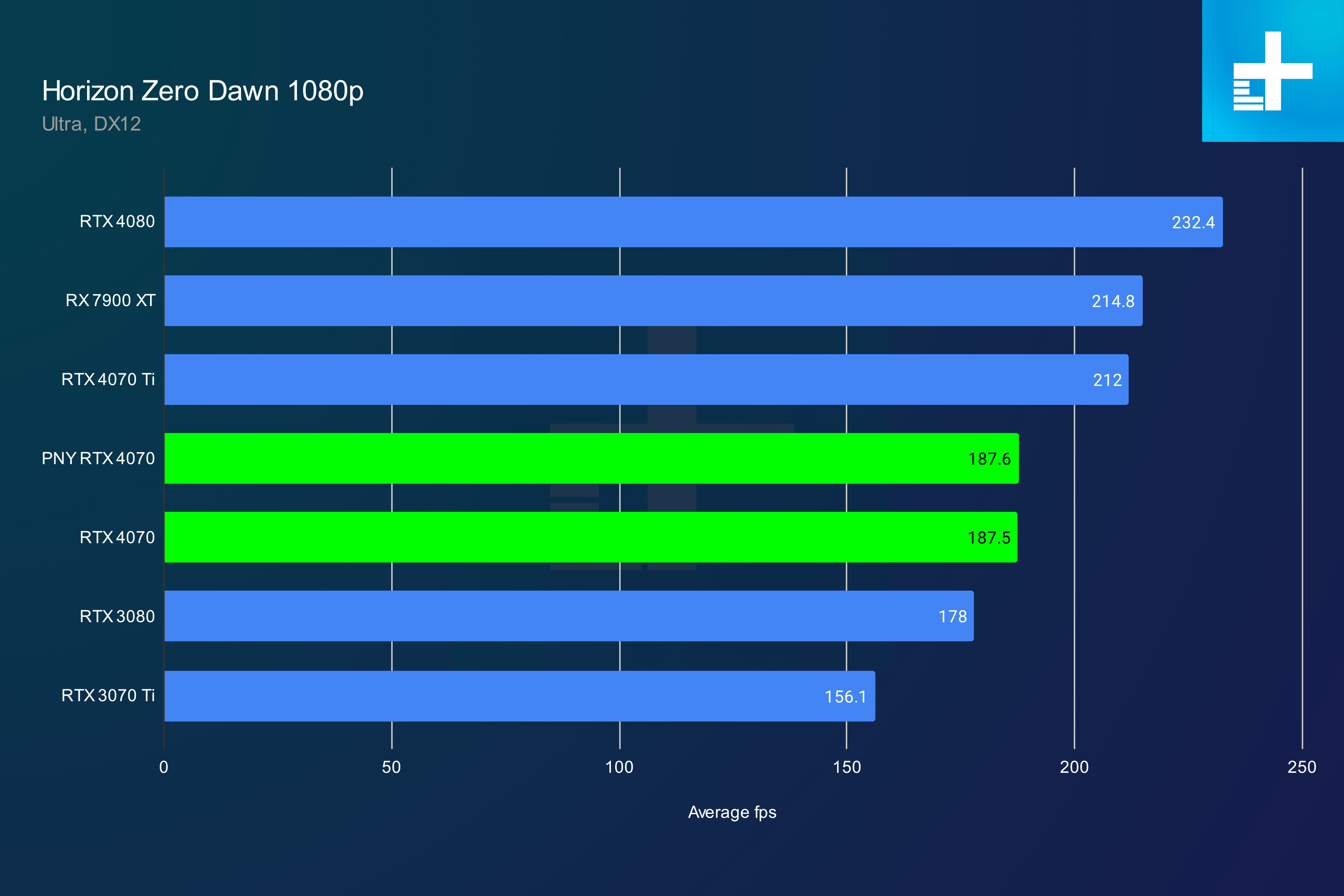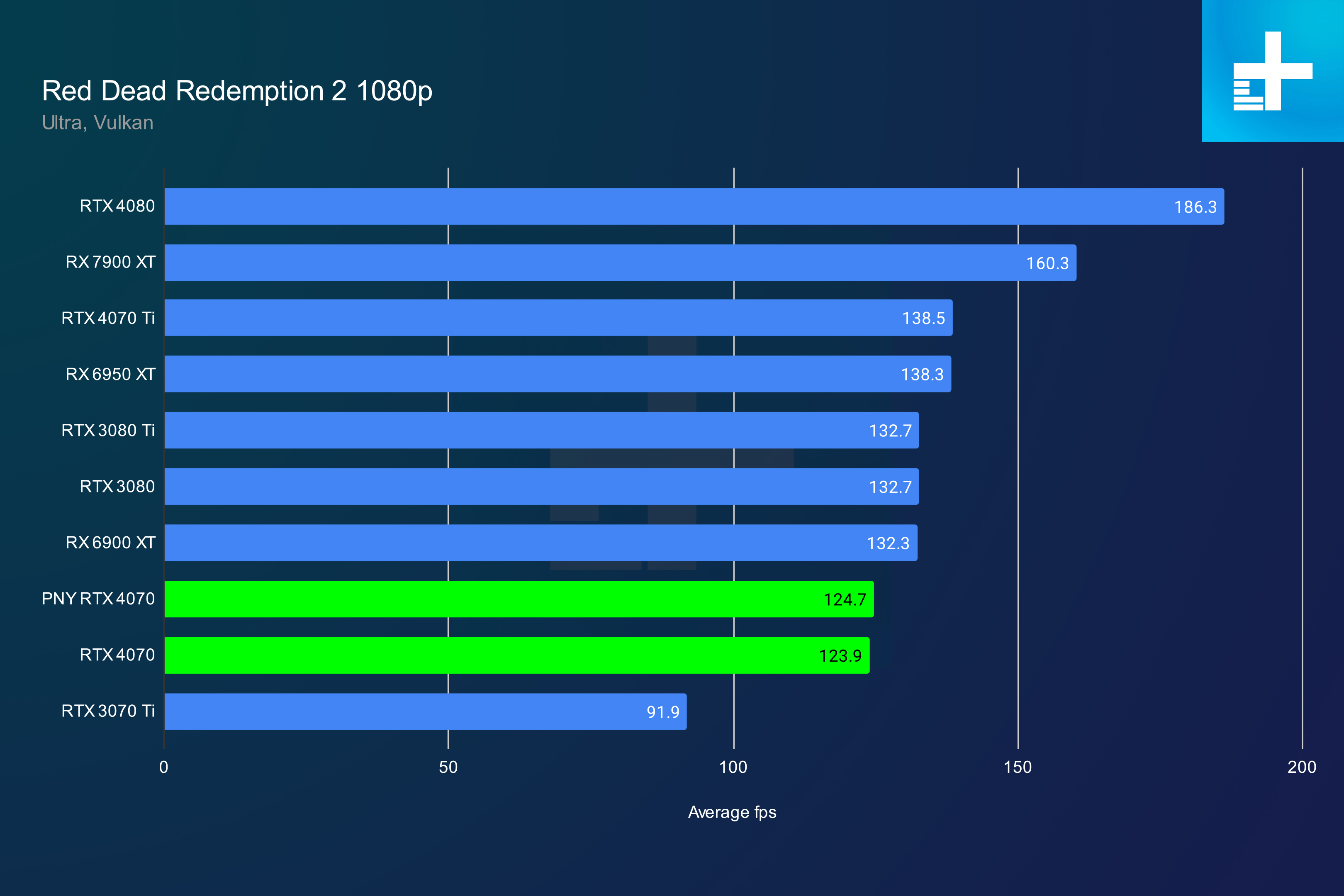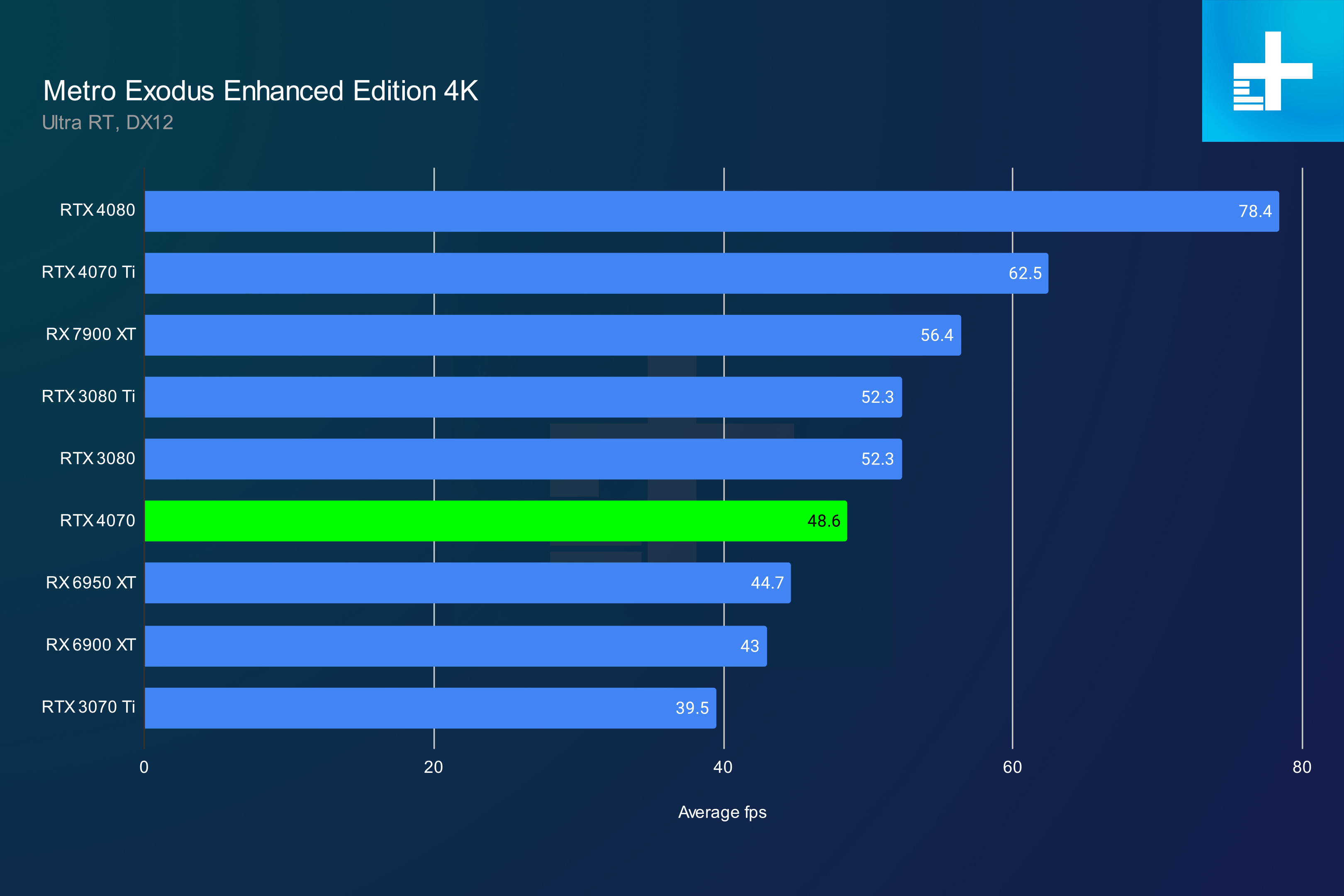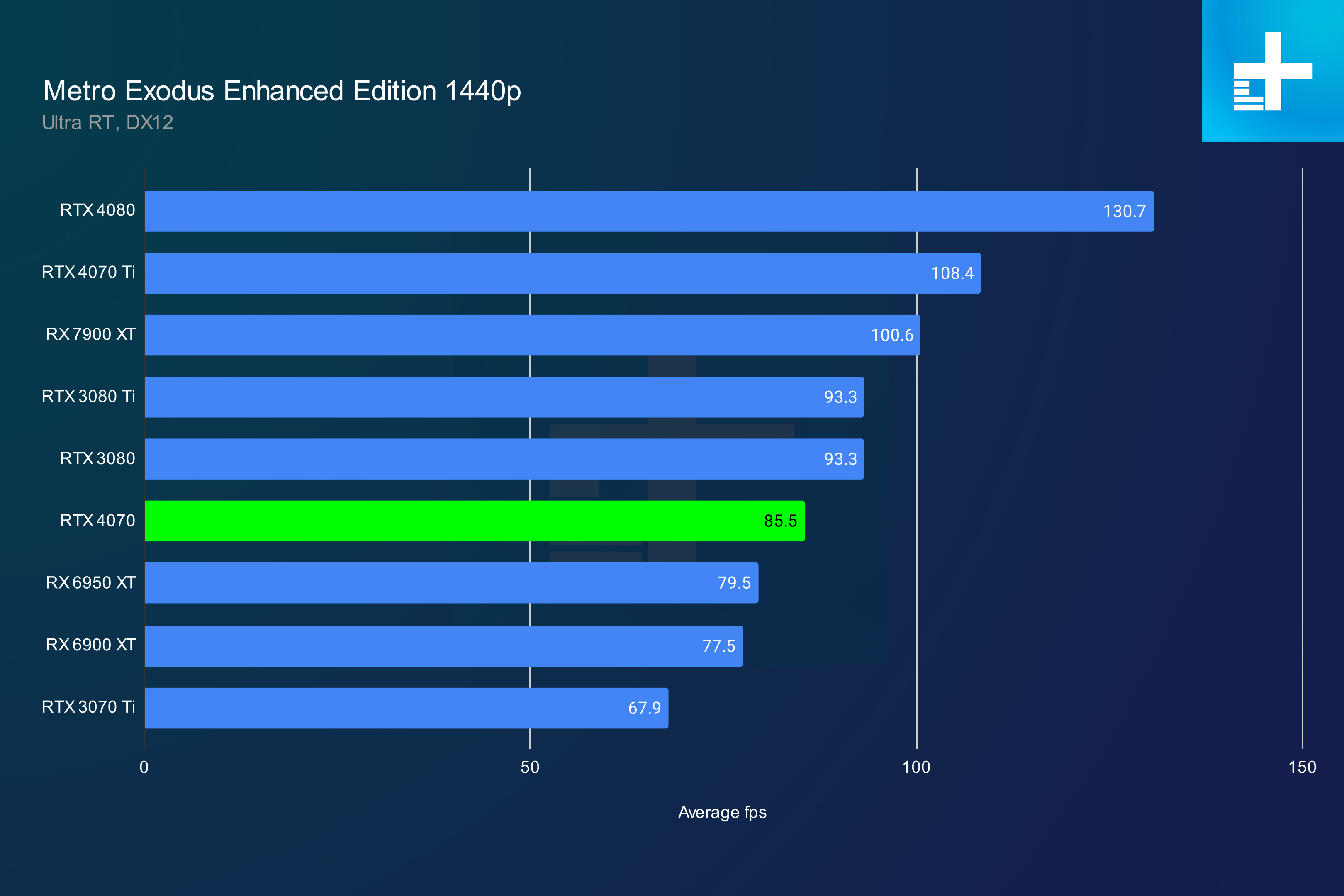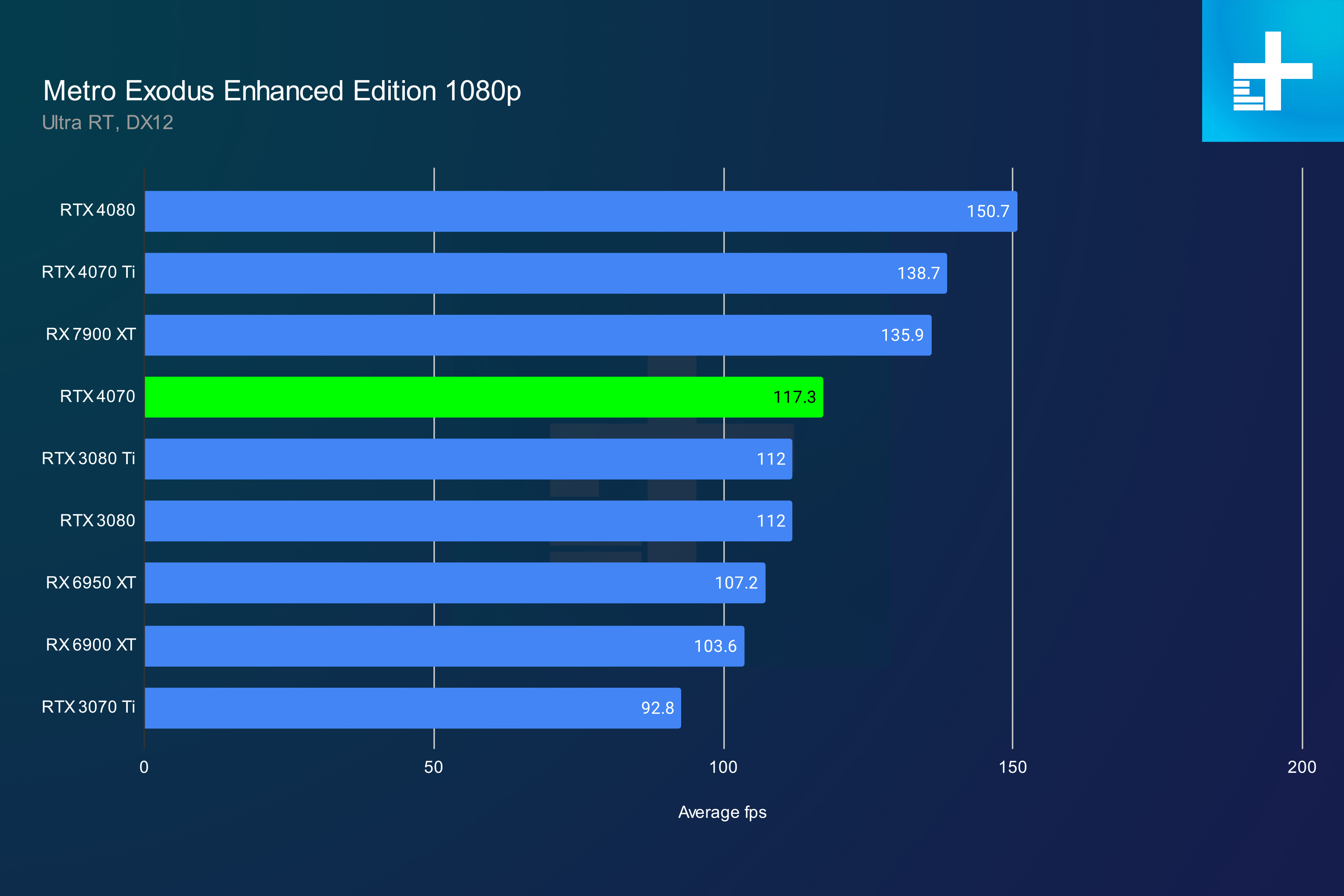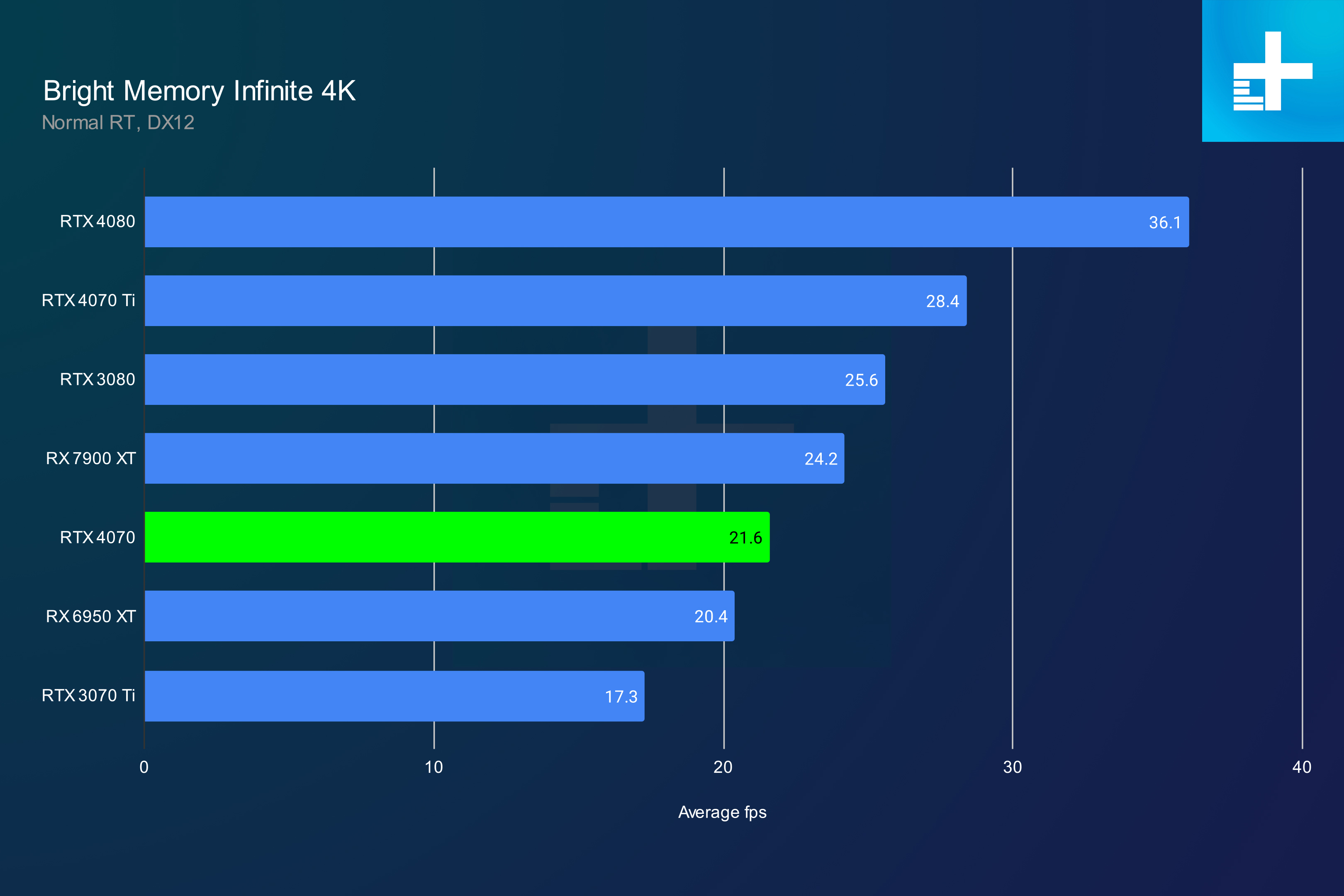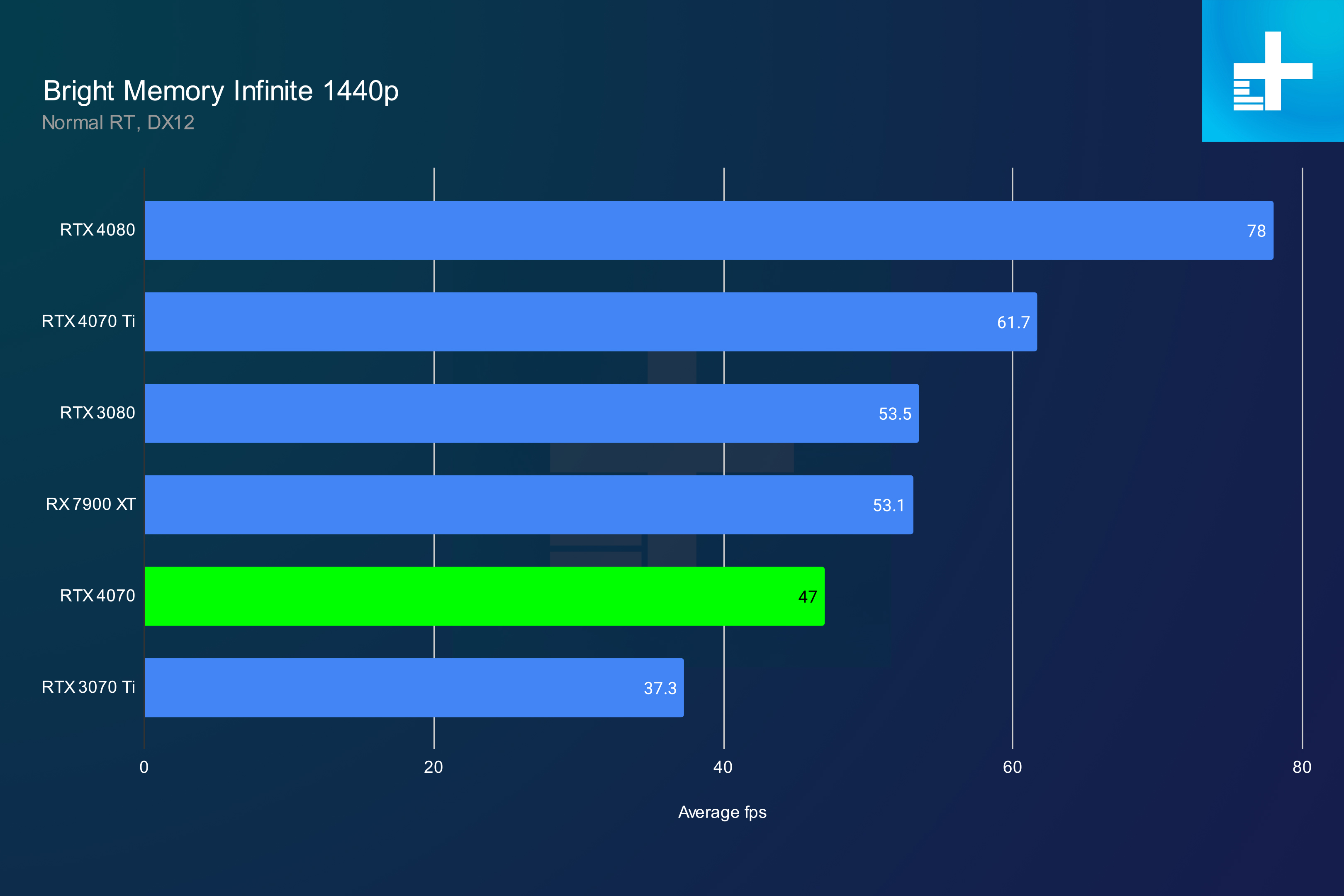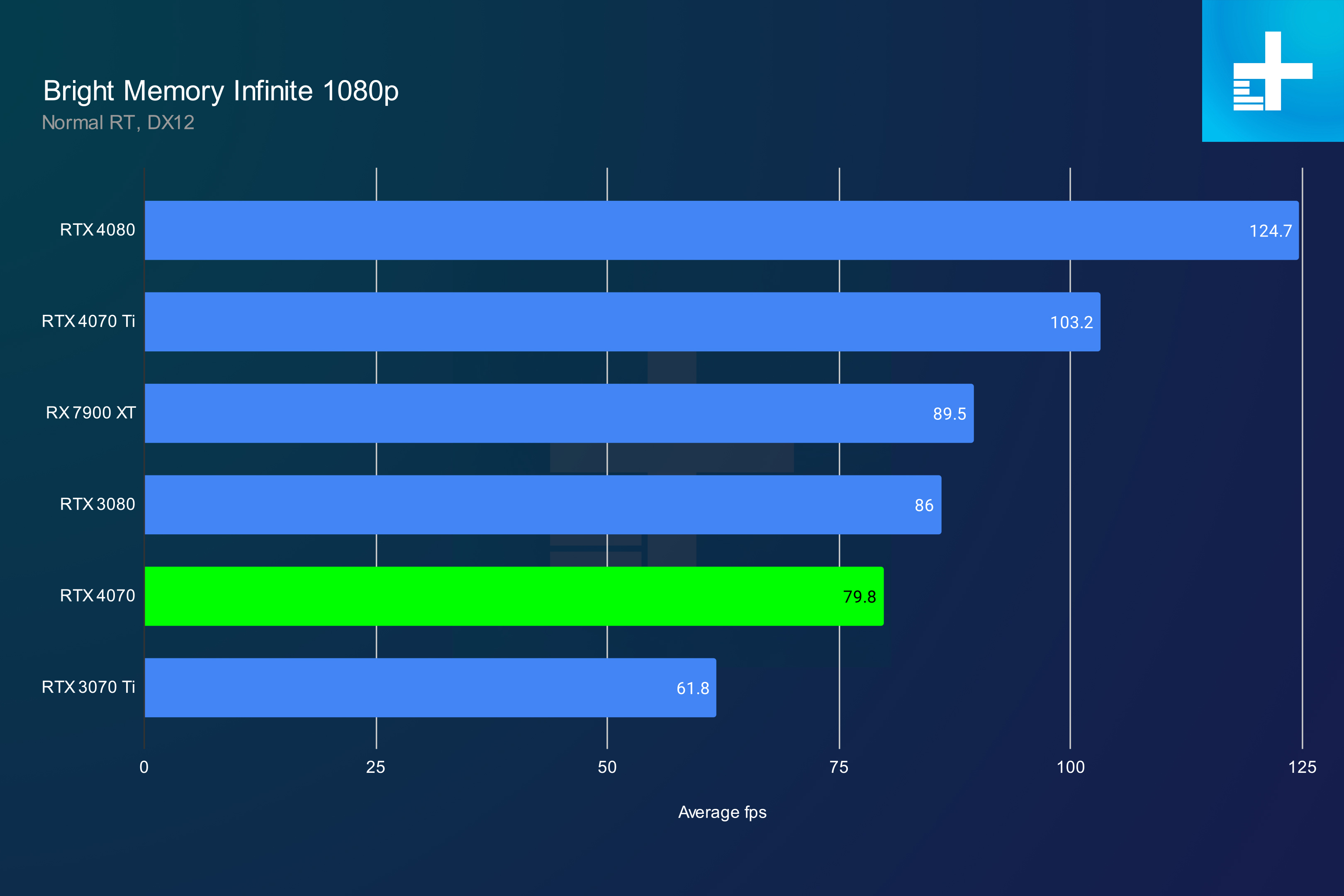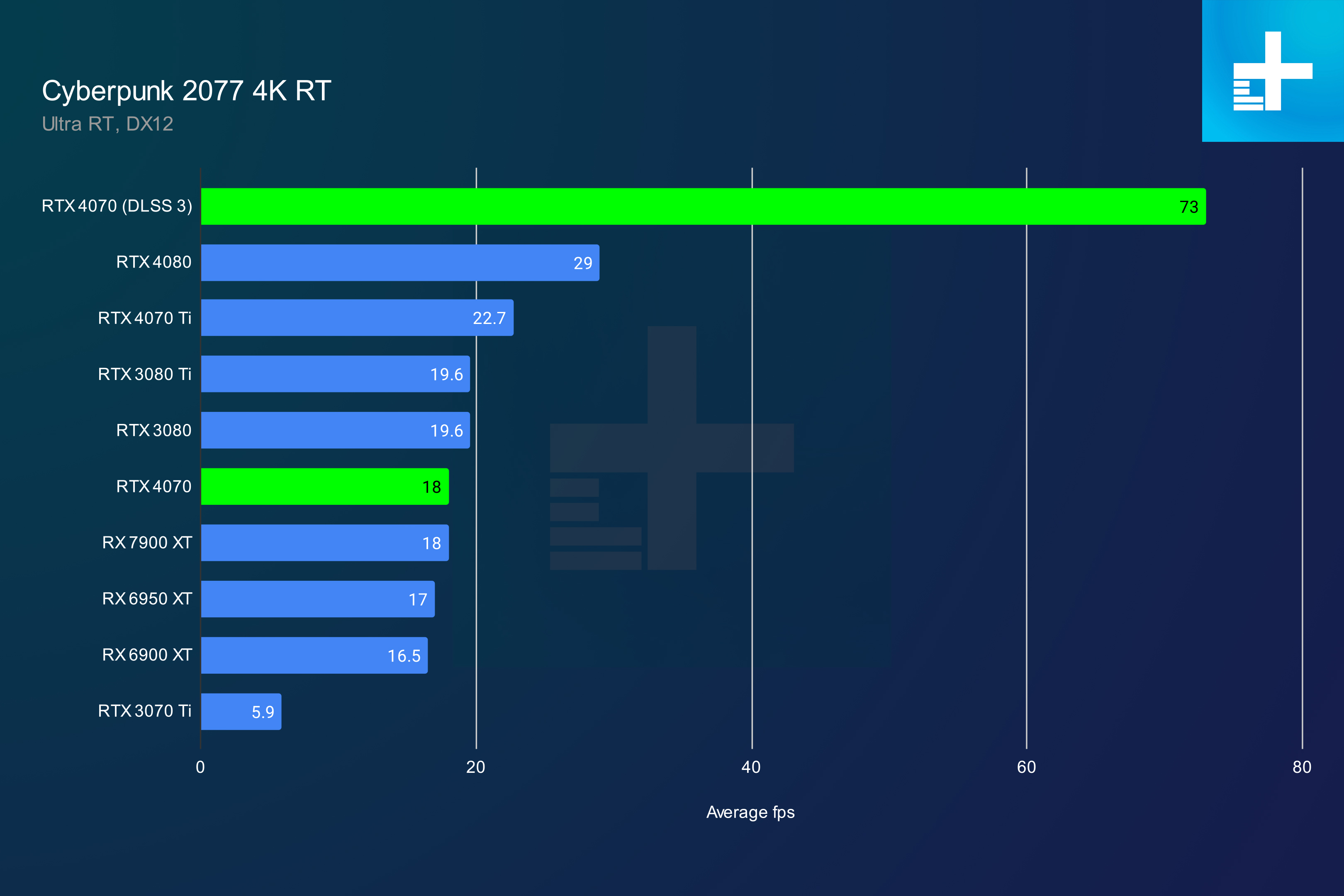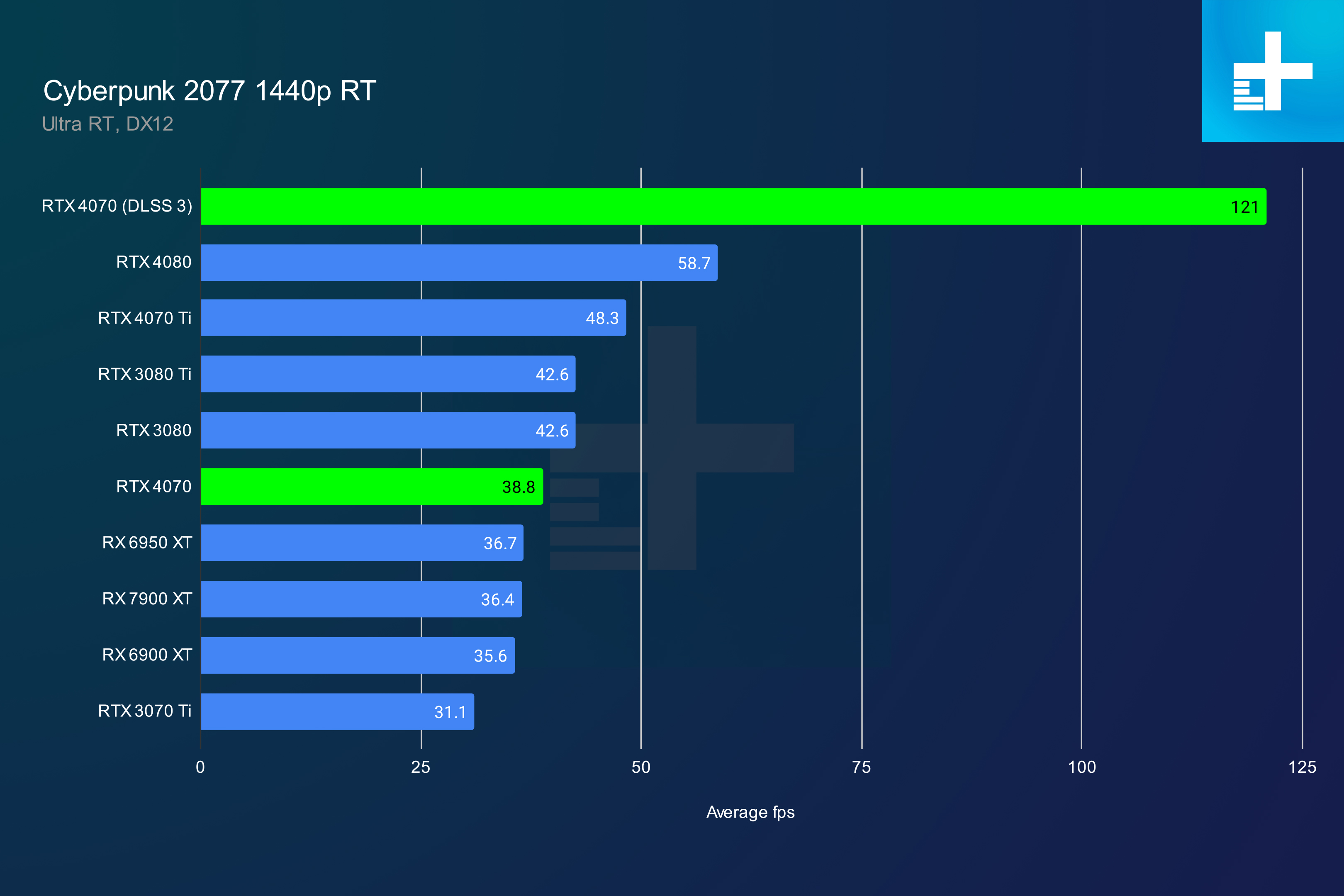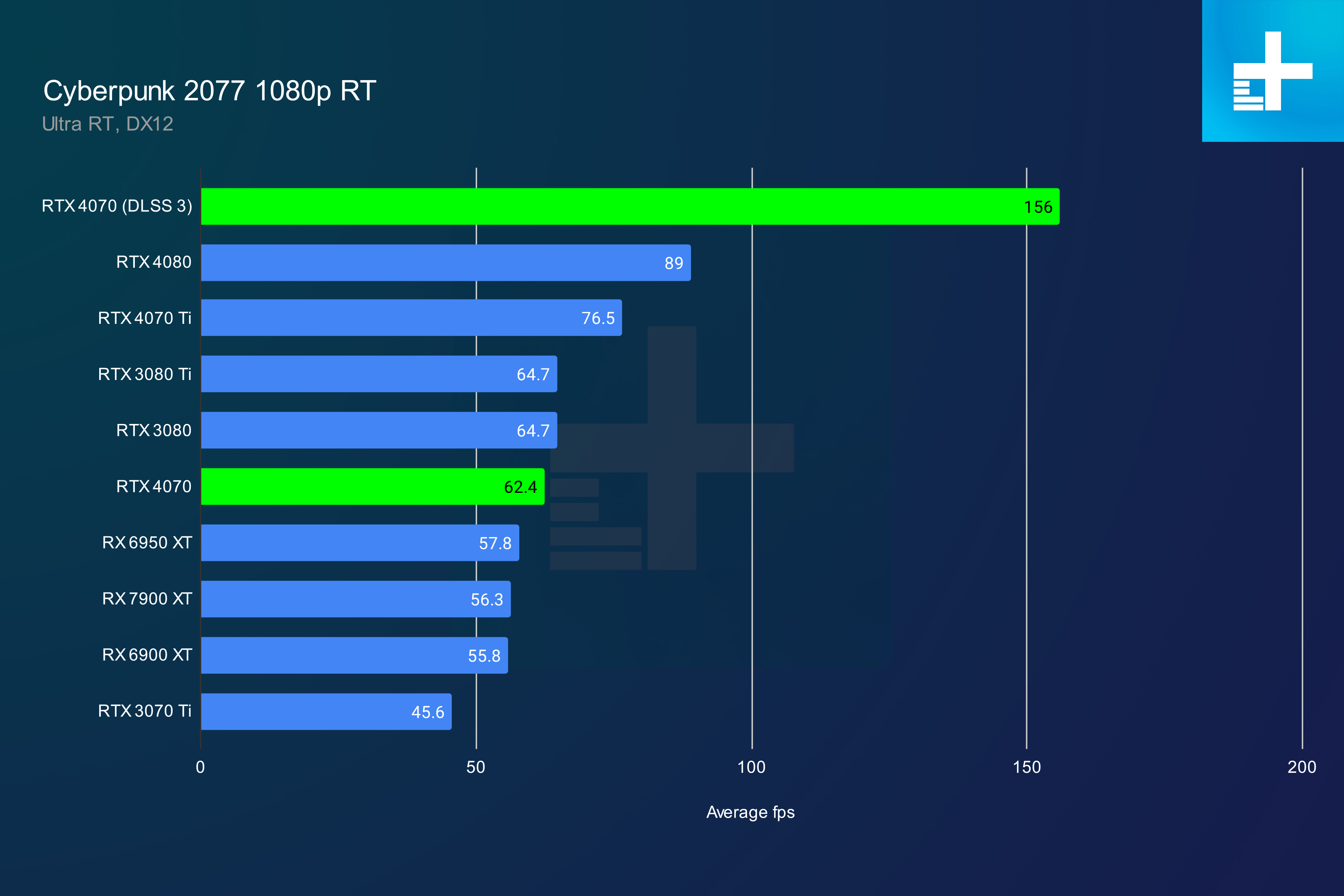- RTX 3080 performance for $100 less
- Only two slots
- DLSS 3
- Remarkable efficiency
- 1440p gaming at 100+ fps
- Beaten by AMD's RX 6950 XT
- Far below RTX 4070 Ti
Nvidia hasn’t been doing great over the past few months. Sure, the company has released some of the best graphics cards you can buy, and if you’re privy to earnings calls, it hasn’t struggled to rake in cash. But the sentiment among gamers has been at a low with a string of powerful, but extremely overpriced, graphics cards. The RTX 4070 is a bid to earn back some lost favor.
It introduces some much-needed value in Nvidia’s RTX 40-series lineup, offering the performance of an RTX 3080 for $100 less and Nvidia’s enticing AI Frame Generation. It’s also destined to be one of Nvidia’s most contentious releases, serving as a sort of Rorschach test for what you value in games.
For the first time in Nvidia’s latest generation, the RTX 4070 asks buyers to weigh pros and cons rather than simply spend up for the latest and greatest. And given the path Nvidia’s pricing has been headed down, that’s a good thing.
Nvidia GeForce RTX 4070 specs

It’s important to list the specs for the RTX 4070 because it’s a very different GPU than the RTX 4070 Ti. Unlike the previous generation where the RTX 3070 and RTX 3070 Ti shared similar specs with the Ti featuring a solid core count boost, the RTX 4070 is in an entirely different class compared to the RTX 4070 Ti.
That’s not a bad thing, as Nvidia has priced the RTX 4070 appropriately. At $600, it introduces some much-needed value into Nvidia’s Ada Lovelace generation. That’s $100 more expensive than last-gen’s RTX 3070, but Nvidia is offering some solid upgrades to justify that price increase.
Most notably, the RTX 4070 comes with the same memory interface as the RTX 4070 Ti. You get 12GB of GDDR6X memory on a 192-bit bus, which is perfect for a card of this caliber. As we’ve seen recently, VRAM limitations in modern games are becoming more pressing, so it’s great to see Nvidia up the spec from the 8GB we saw in the previous generation.
| RTX 4070 | RTX 4070 Ti | |
| Architecture | Ada Lovelace | Ada Lovelace |
| Process node | TSMC N4 | TSMC N4 |
| CUDA cores | 5,888 | 7,680 |
| Ray tracing cores | 46 3rd-gen | 60 3rd-gen |
| Tensor cores | 184 4th-gen | 240 4th-gen |
| Boost clock speed | 2,475MHz | 2,610MHz |
| VRAM | 12GB GDDR6X | 12GB GDDR6X |
| Memory clock speed | 10,500MHz | 10,500MHz |
| Memory data rate | 21 Gbps | 21 Gbps |
| Bus width | 192-bit | 192-bit |
| Total Graphics Power (TGP) | 200W | 285W |
Although there’s a solid reduction in core count across the board — 23% fewer CUDA, Tensor, and ray tracing cores compared to the RTX 4070 Ti — but the RTX 4070 is able to overcome that gap when it comes to real-world performance. That’s despite a slightly slower clock speed, too. Honestly, though, you could make up the clock speed of the RTX 4070 Ti with a bit of manual overclocking.
There’s a positive here for lower specs: less power. The RTX 4070 comes with a Total Graphics Power (TGP) of only 200 watts, which is 20W less than the RTX 3070 and nearly 90W less than the RTX 4070 Ti and RTX 3070 Ti. We’ve already seen the efficiency of Nvidia’s Ada Lovelace generation in practice, but the RTX 4070 is a perfect showcase of it.
For my review, I actually tested two cards: Nvidia’s Founder’s Edition design as well as a PNY version. According to PNY, the model I tested will be available for the list price of $600. There aren’t any big surprises in performance between the two, though I was delighted to see that the PNY card only required a single 8-pin power connector. Nvidia’s design comes with an adaptor for dual 8-pin power, but PNY’s model suggests there are at least a few cards that only need a single plug.
Synthetic and rendering

I always like to set the scene for a graphics card review with some high-level benchmarks. 3DMark is the best place to do that, even if it isn’t a perfect showcase of how powerful a graphics card really is. In the DirectX 12-based Time Spy, the RTX 4070 comes in just shy of the RTX 3080, trailing by about 6%. It fell behind AMD’s RX 6950 XT by a larger 14%, though the RTX 4070 makes up for that gap with better performance in Port Royal.
Port Royal is a ray tracing benchmark, and AMD has struggled to match Nvidia’s ray tracing performance for the past two generations. The RTX 4070 is around 8% faster than the RX 6950 XT when ray tracing is brought into the fold, though it still fell behind the RTX 3080 by about 10%.

Outside of gaming performance, Nvidia is competing with itself in Blender. The 3D modeling application is accelerated by Nvidia’s CUDA library, and even AMD’s most powerful cards barely register on my chart. The RTX 4070 offers some massive generational improvements in Blender, with the card offering around a 50% improvement compared to the RTX 3070 Ti.
4K gaming performance

Nvidia is firmly billing the RTX 4070 as a 1440p graphics card, but it has some significant 4K gaming prowess considering its price. Across my full test suite, including ray tracing titles, it ended up 35% faster than the RTX 3070 Ti and about 4% slower than the RTX 3080. I only had the 12GB RTX 3080 on hand to test, so that lead shrinks with the 10GB model.
That performance falls in line with how Nvidia is framing this card — the company is claiming RTX 3080-like performance for $100 less than that card debuted at. There’s some significant competition from the other side in the form of the RX 6950 XT, though. It’s very difficult to find the RTX 3080 in stock for $700, but you can find the RX 6950 XT for around $650, and it’s slightly faster than the RTX 4070.
The RX 6950 XT claims some notable leads over the RTX 4070 in Red Dead Redemption 2, Horizon Zero Dawn, and Assassin’s Creed Valhalla at 4K. On the flip side, though, Nvidia is able to match AMD’s last-gen flagship in Cyberpunk 2077 and Gears Tactics.
There’s a big boost for Nvidia here, too: Deep Learning Super Sampling (DLSS) Frame Generation. For the two games in my test suite that support DLSS Frame Generation — Cyberpunk 2077 and Forza Horizon 5 — I tested the RTX 4070 with it turned on in addition to my standard runs. This feature is available to all RTX 40-series graphics cards including the RTX 4080 that dominates in native performance, but it’s not available to the RX 6950 XT.
That can make a huge difference as showcased by Cyberpunk 2077. That game includes AMD’s FidelityFX Super Resolution (FSR) upscaling, but it’s DLSS Frame Generation that allows the RTX 4070 to more than double its native performance. Only a select few games have DLSS 3 right now, but the list is focused on very demanding titles like Cyberpunk 2077 and Portal RTX.
Zooming back out, the RTX 4070 is about 15% slower than the RTX 4070 Ti while costing 25% less. That’s a solid value proposition, and a good showcase of how out of sorts Nvidia’s pricing is higher up the stack (the RTX 4080, for instance, is 47% faster than the RTX 4070 and 100% more expensive). Compared to Nvidia’s lineup, the RTX 4070 is a smash success. But as my 1440p testing shows, the RX 6950 XT still stands as a potent threat.
1440p gaming performance

At a high level, the RTX 4070’s 1440p performance doesn’t look much different than its 4K performance. It managed to match the 12GB RTX 3080 at 1440p, which is a solid win, but it ends up around 6% slower than the RX 6950 XT (that compares to around 3% at 4K). The difference is that instead of relying on a few games, the RTX 4070 shows much better scaling across my test suite at 1440p.
Forza Horizon 5 is a great showcase of that. At 4K, the RTX 4070 is firmly behind the RX 6950 XT, with it being around 11% slower. At 1440p, that gap shrinks to a minor 2%. The RTX 4070 keeps pace in Gears Tactics with the RX 6950 XT, as well, and although it’s slower in Red Dead Redemption 2 by around 15%, that’s the same factor I saw at 4K.
Unfortunately for Nvidia, that scaling works in the opposite direction, as well. At 4K, the RTX 4070 was able to match the RX 6950 XT in Cyberpunk 2077, but at 1440p, it ends up around 15% slower. And in Assassin’s Creed Valhalla, it goes from 10% slower at 4K to 15% slower at 1440p.
Once again, the RTX 4070 is making up ground when it comes to ray tracing. Ignoring ray tracing, it ends up around 15% slower than the RX 6950 XT for around the same price. Raw frame chasers are better off with AMD’s card, but the higher ray tracing performance and DLSS 3 help balance the scales for Nvidia.
1080p gaming performance
It’s hard to justify spending $600 on a graphics card for 1080p gaming, but the RTX 4070 looks much more attractive at this resolution. It still ends up slower than the RX 6950 XT, but the card is able to claim some wins while outpacing the RTX 3080 Ti and sometimes getting close to the RTX 4070 Ti.
In Cyberpunk 2077, for example, the RTX 4070 is around 11% slower than the RTX 4070 Ti despite costing 25% less. When games like Forza Horizon 5 become limited by the CPU, the RTX 4070 is able to scale up, as well. In my testing, it managed to even match the RX 7900 XT, though you should keep in mind that not all games will become this limited by the CPU at 1080p.
In other titles, the RTX 4070 shows tighter performance with competitive cards due to for stress being put on the CPU. Although pricey for a 1080p graphics card, it’s not a bad current-gen option assuming you plan to upgrade to a 1440p or 4K display somewhere down the line.
Ray tracing and DLSS 3
The RTX 4070 hangs its hat on ray tracing and DLSS 3, and for good reason. As I covered in the above sections, the card is slower than the RX 6950 XT across resolutions, but it makes up a lot of ground when you factor in titles with ray tracing.
In Metro Exodus Enhanced Edition, for example, the RTX 4070 is faster than the RX 6950 XT by a solid 9% at 4K. And in Bright Memory Infinite, it’s ahead by 6%. That gap widens at lower resolutions, too. In Metro Exodus at 1080p, for example, the RTX 4070 is even 5% faster than the RTX 3080 Ti; a GPU that launched with a list price of $1,200.
Those leads are impressive, but Cyberpunk 2077 is the premier showcase for a card like the RTX 4070. At 4K, this is one of the most constrained titles you can play right now, as evidenced by the fact that the RTX 4070 keeps pace with the RX 7900 XT (a GPU that, by every other metric, is leagues faster). DLSS 3 breaks that stalemate in a huge way.
Nvidia has DLSS and AMD has FSR, and although DLSS is slightly better, both offer a great way to boost your frame rate without a major loss in image quality. With DLSS 3 offering Frame Generation, however, Nvidia’s tech is firmly back in the lead by making an otherwise unplayable game like Cyberpunk 2077 enjoyable.

As you can read in my RTX 4090 review, there are still some minor problems with DLSS 3, but they’re very easy to overlook given how much of a performance boost it offers. You’re going from 18 frames per second (fps) in Cyberpunk 2077 to nearly 80 fps, which is a gain that just isn’t possible with the super-resolution methods like DLSS 2 and FSR. It’s Frame Generation that makes the difference.
You don’t need DLSS 3, but it is a big perk for a card like the RTX 4070. The most demanding games available today like Portal RTX and Warhammer 40,000 Darktide are tough to run on AMD’s most recent and powerful GPUs. They would be hard to run on Nvidia’s, too, but DLSS 3 makes those games possible.
A next-gen showcase

The RTX 4070 feels like a turning point for Nvidia’s RTX 40-series range in a number of ways. For starters, it finally introduces some value into the generation, offering a clear upgrade path for high-end gamers with an RTX 3070 or RTX 3070 Ti that falls in line with last-gen prices. More importantly, though, it’s a turning point for the tech Nvidia has been building for years.
You’re getting performance on the level of an RTX 3080 for $100. That’s a decent generational jump, even if it’s to be expected. Where the RTX 4070 excels is DLSS 3 and ray tracing, serving as a midrange showcase for the tech that has been exclusive to the most expensive graphics cards up to this point.
That doesn’t mean it’s the right choice for everyone. AMD’s RX 6950 XT is a fierce competitor around the same price, and in a large swath of purely rasterized games, it’s the better pick. For gamers that want to see what next-gen looks like, though, there’s no trumping the RTX 4070 for now.





